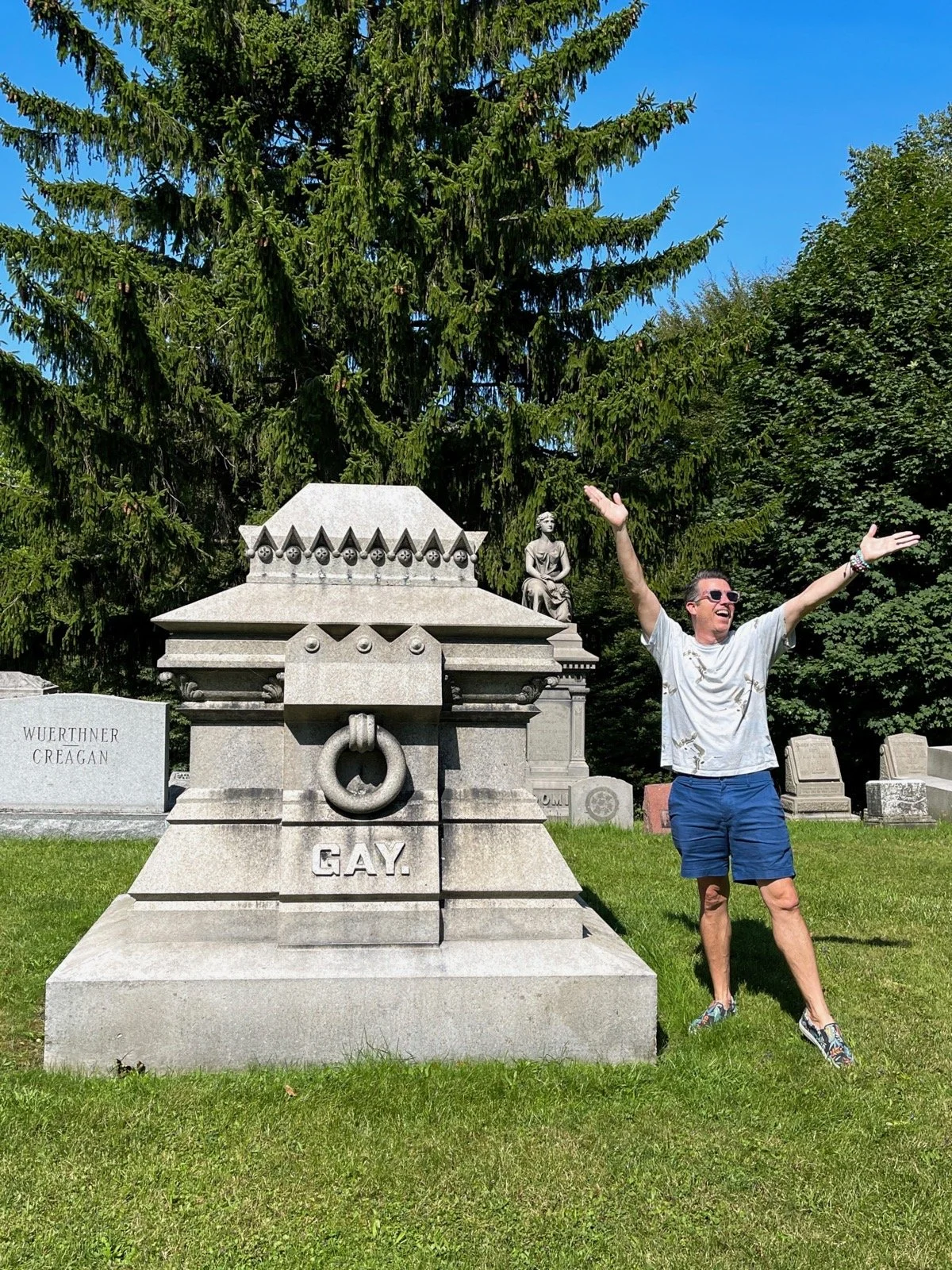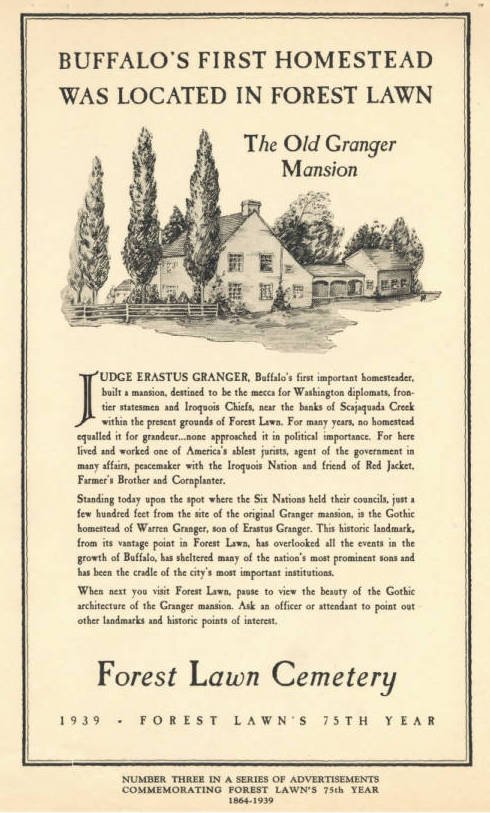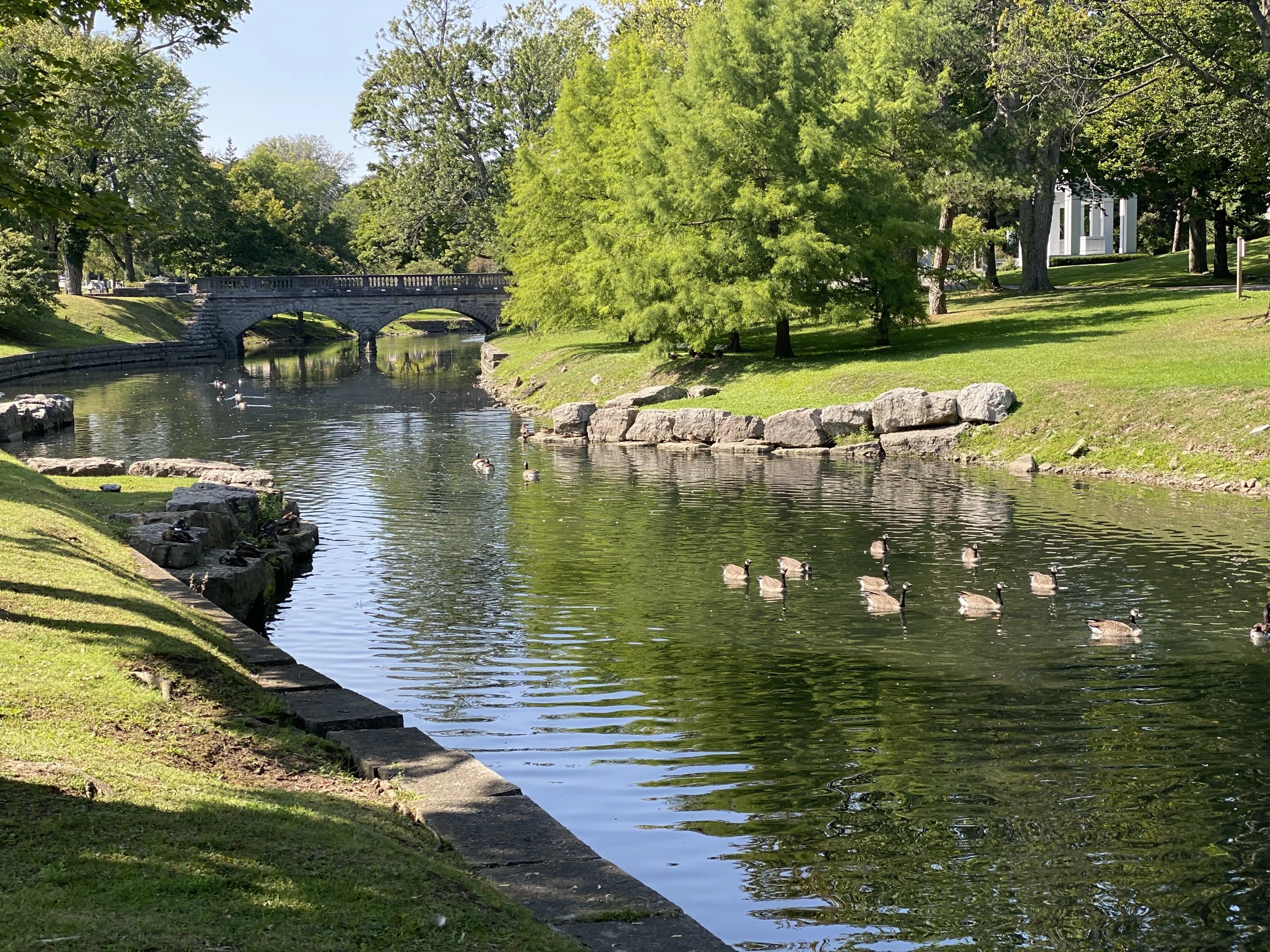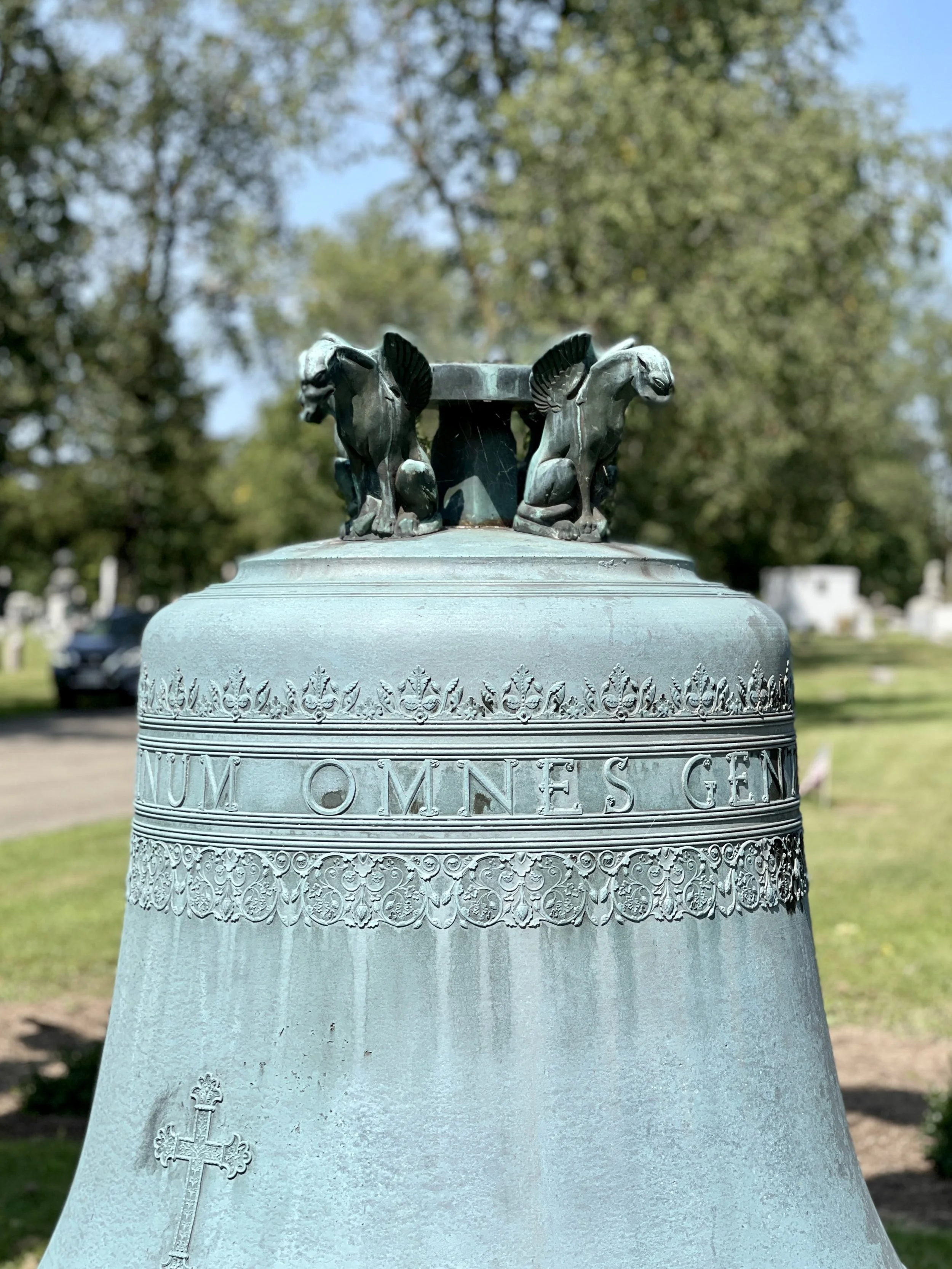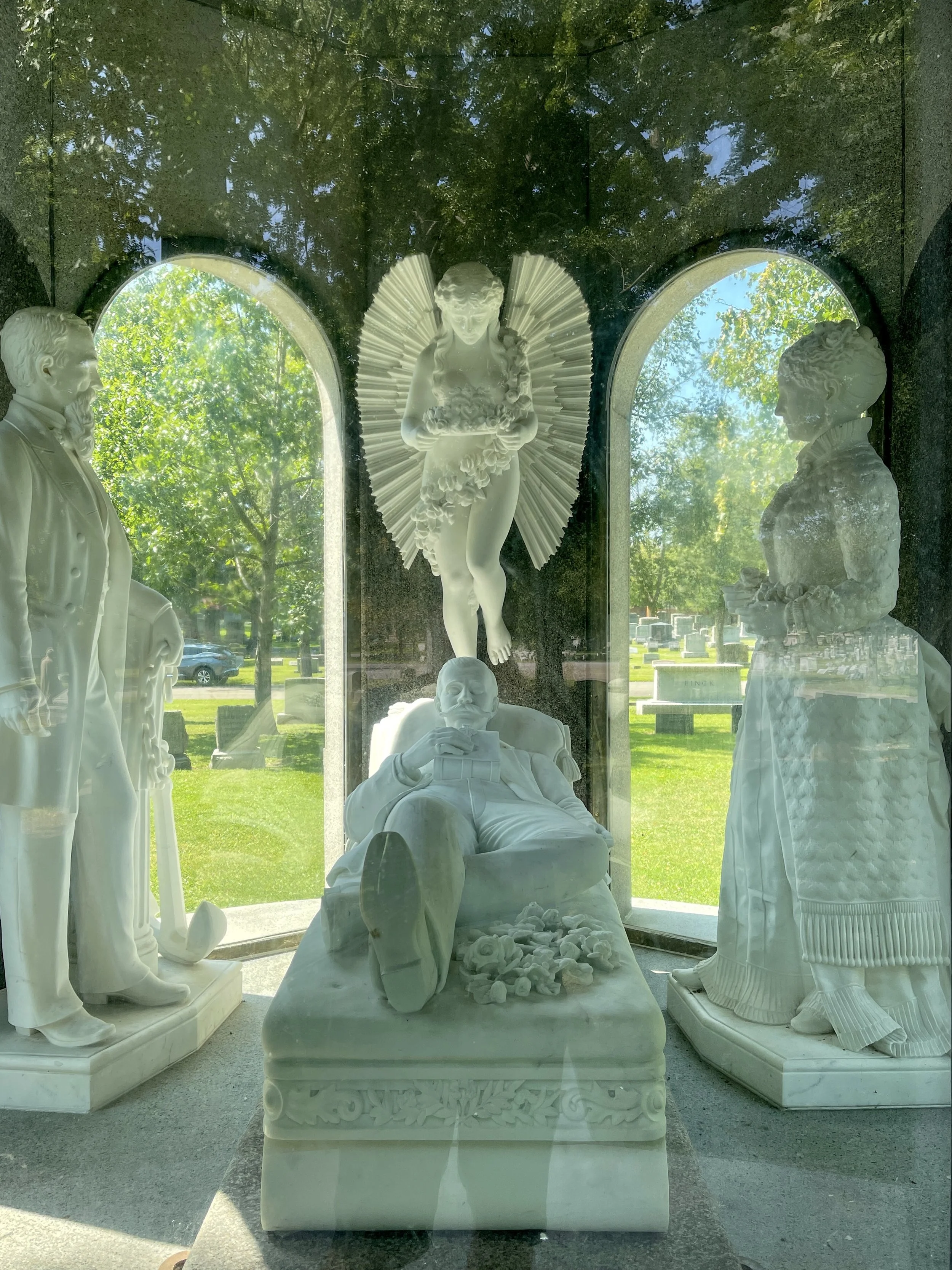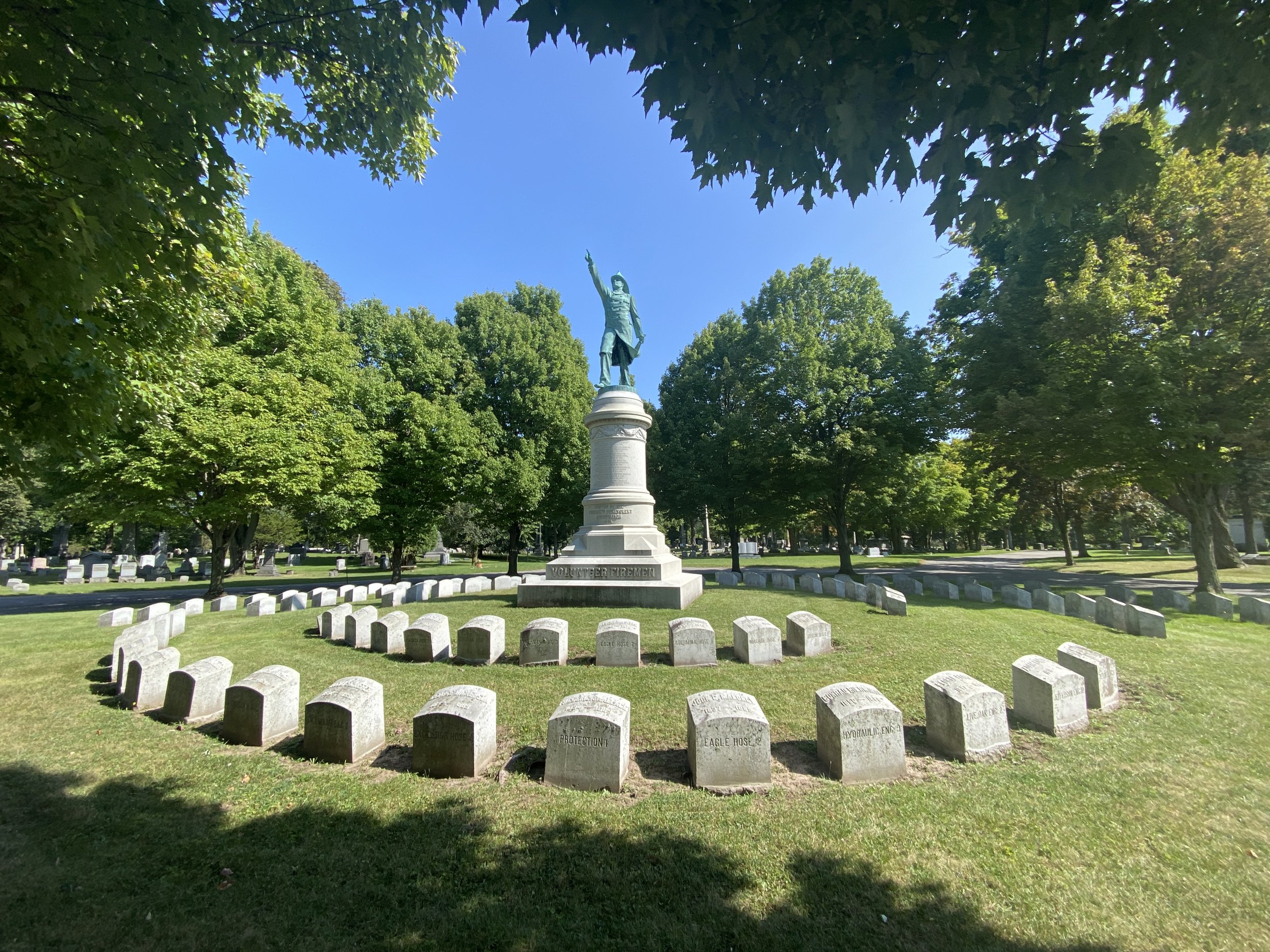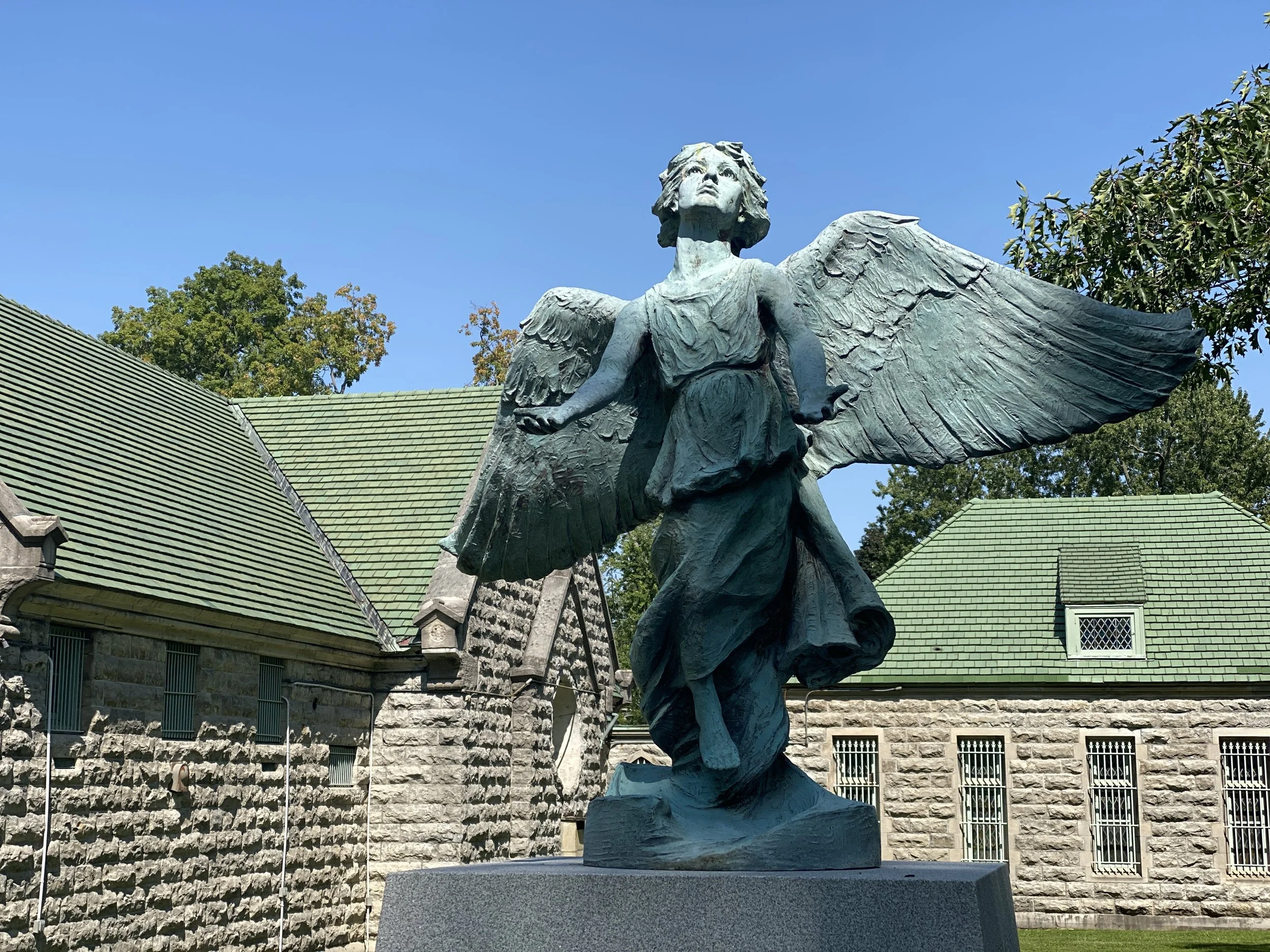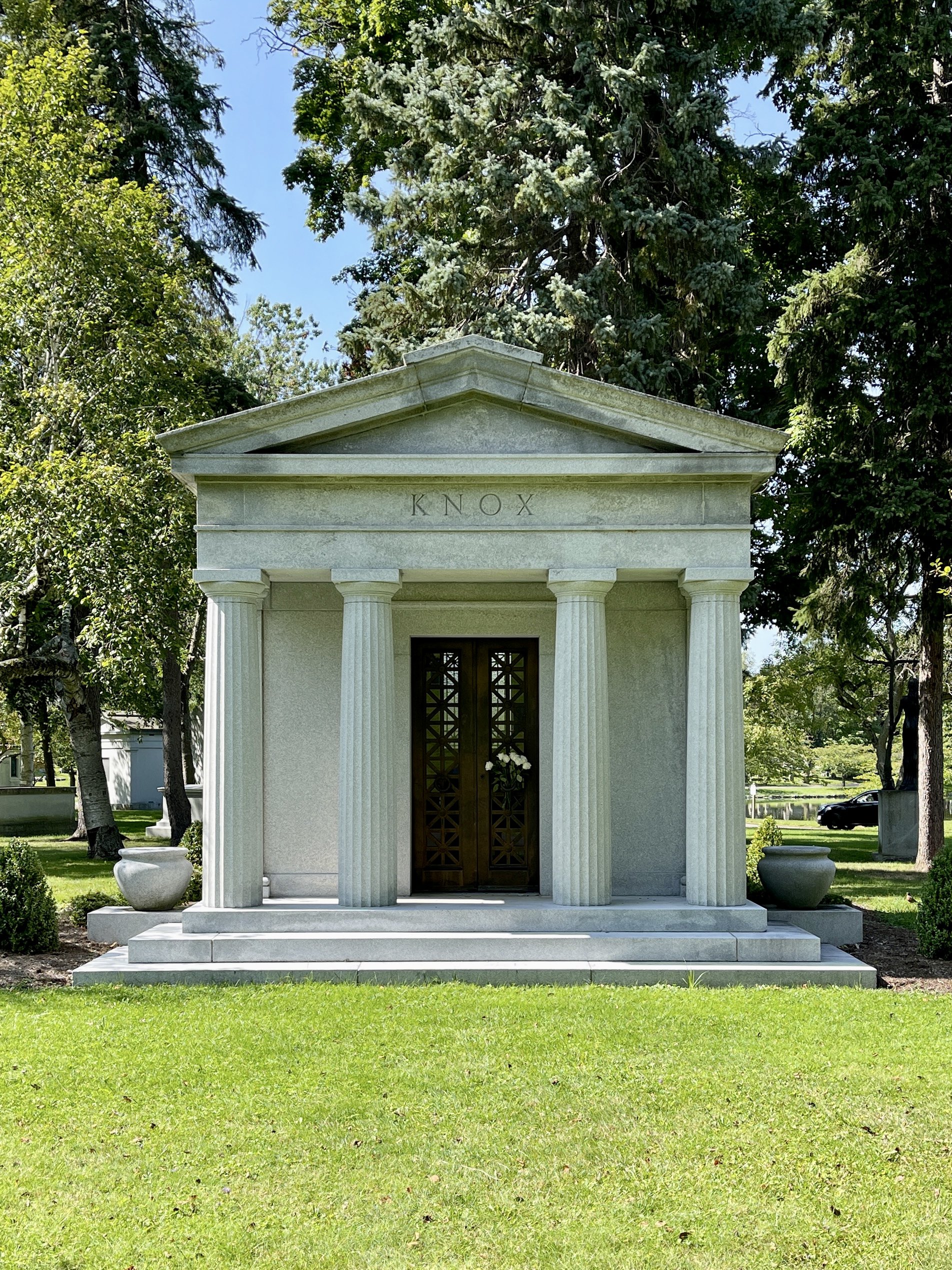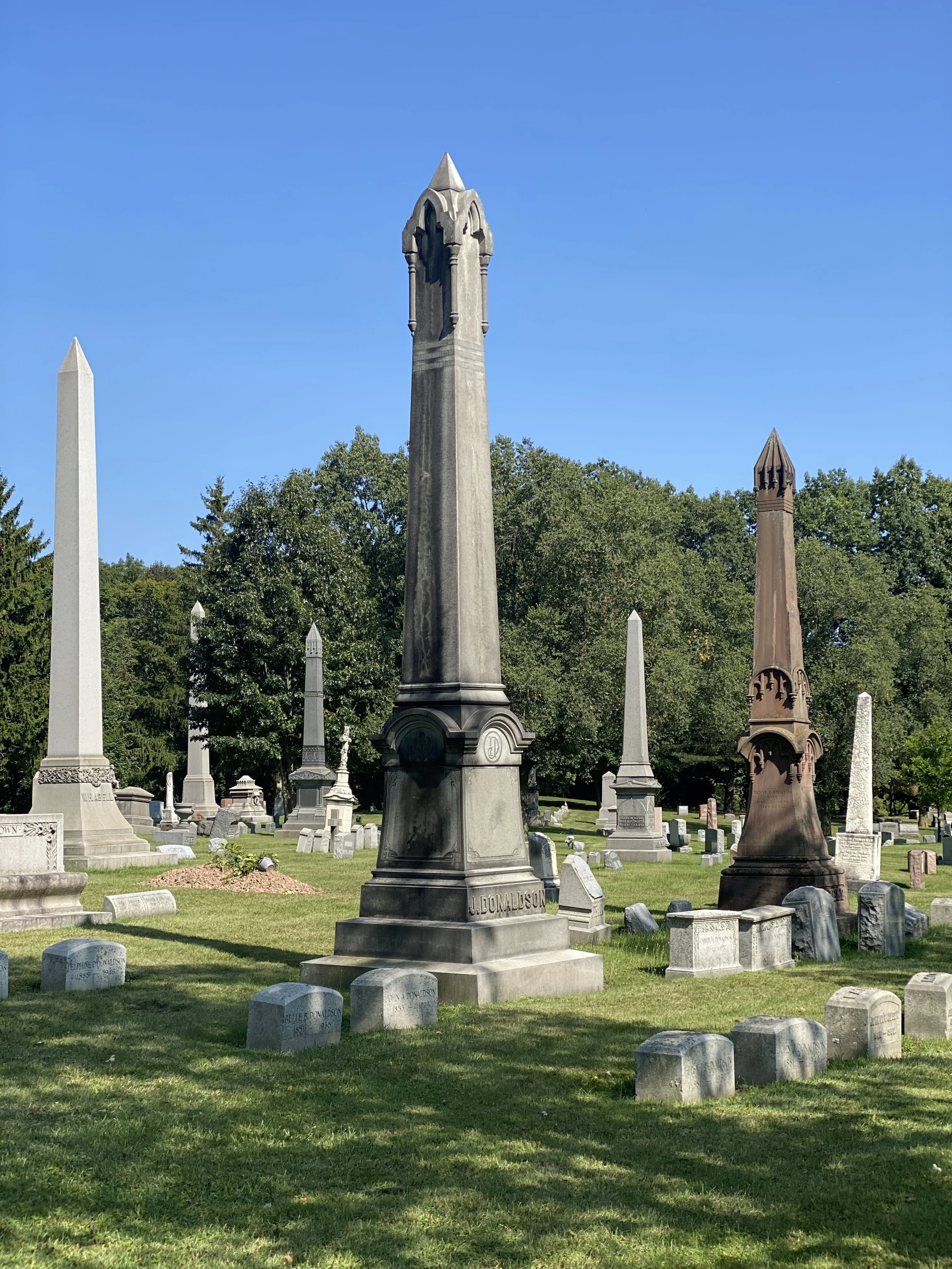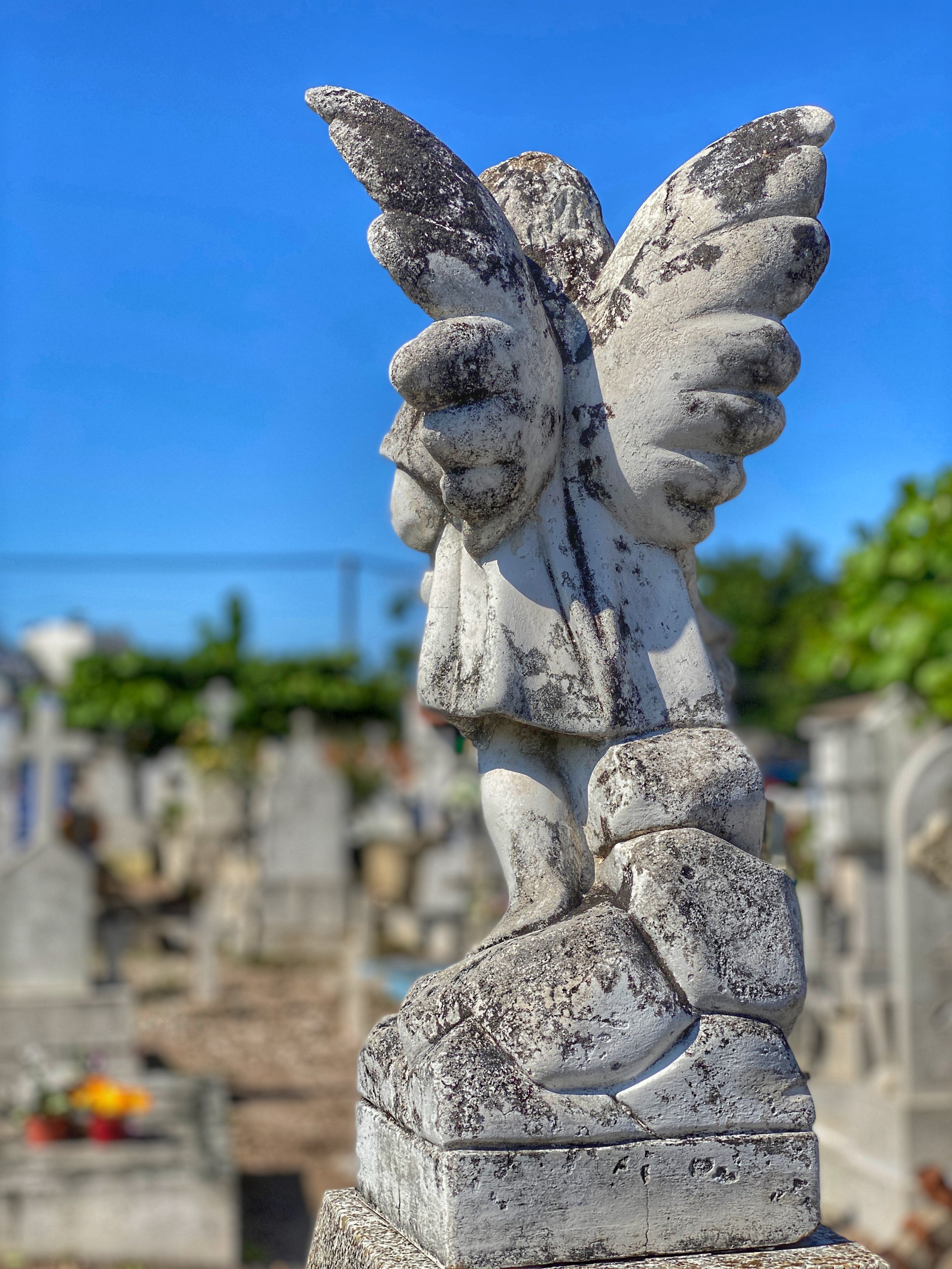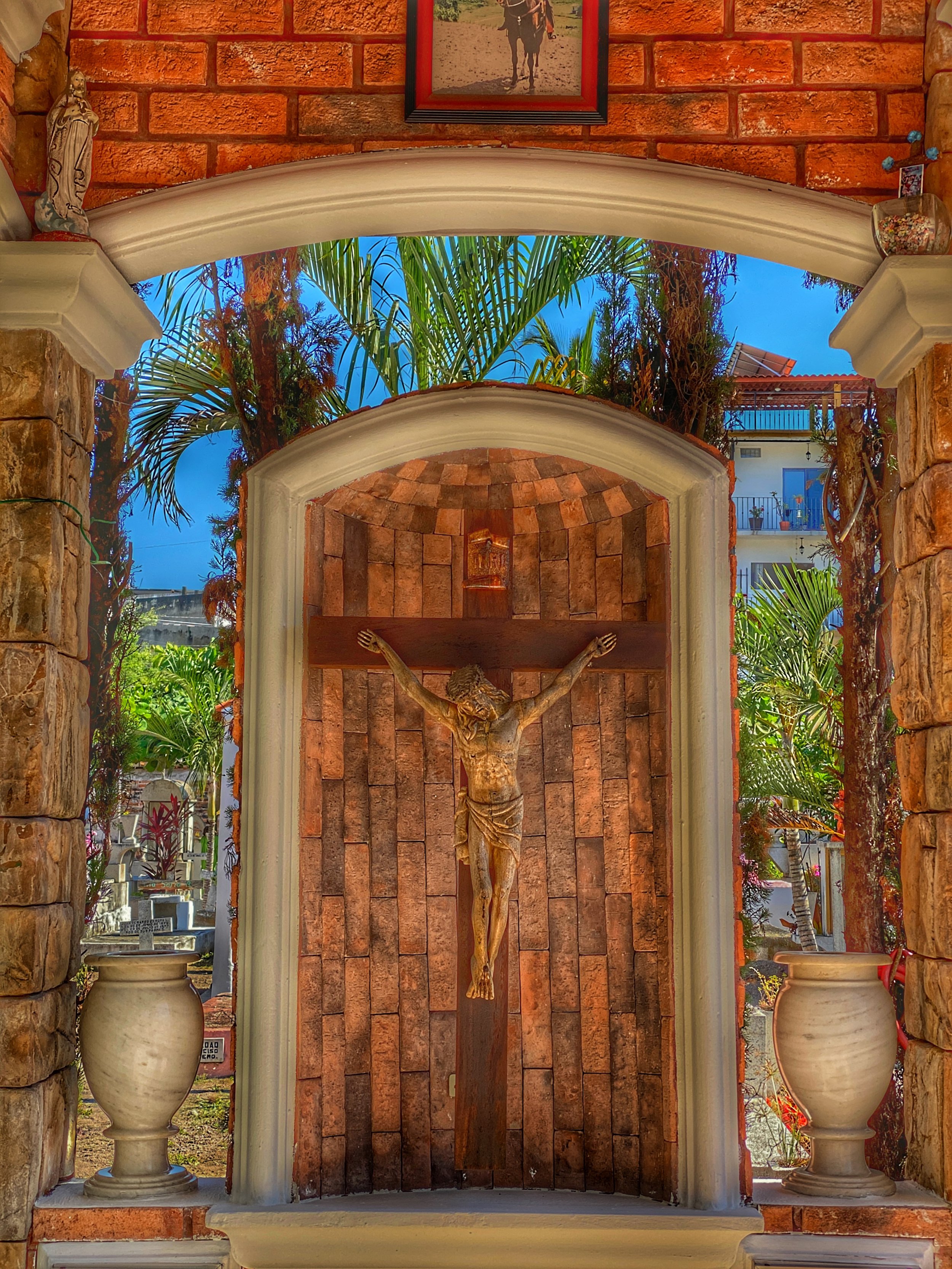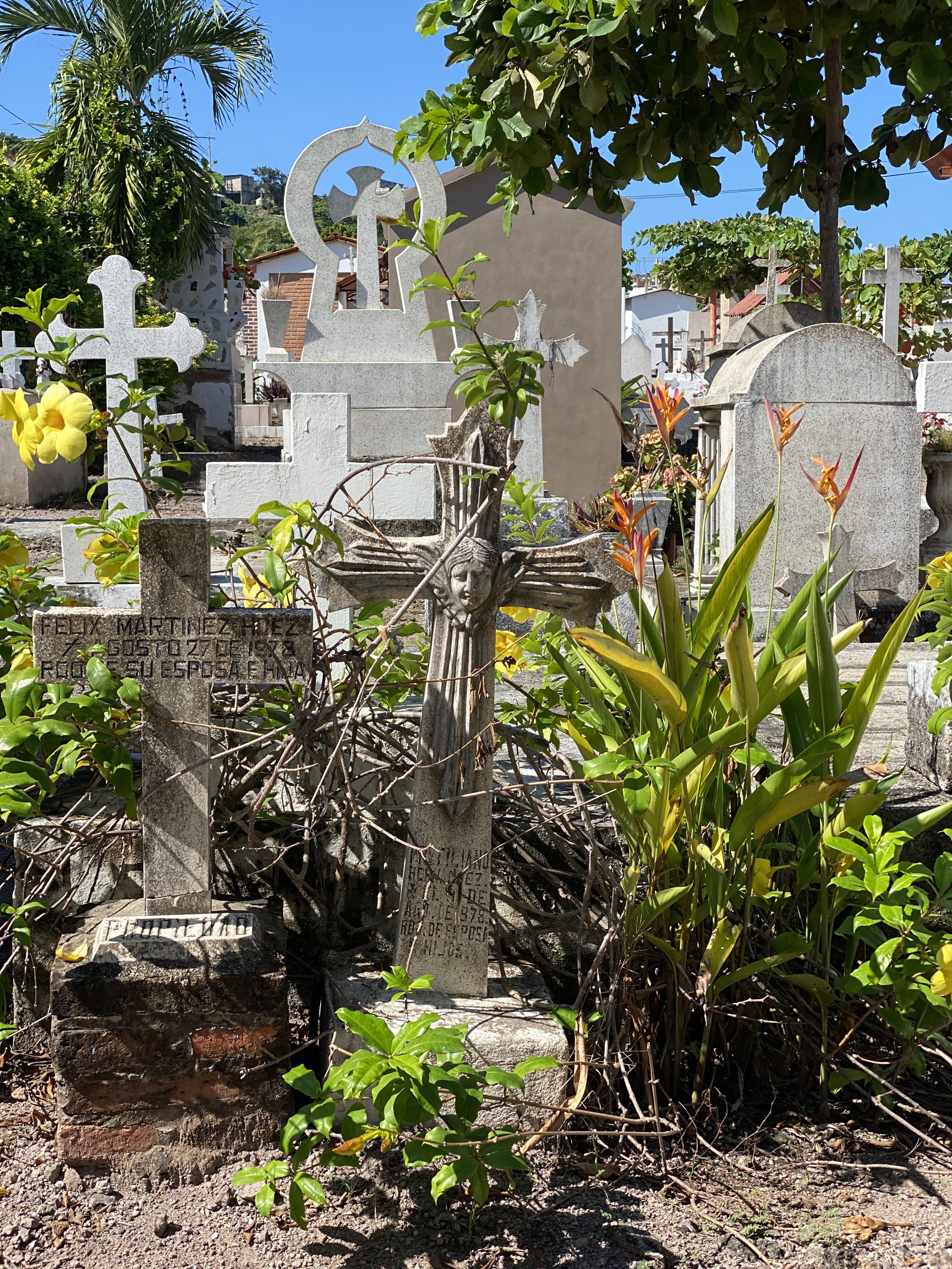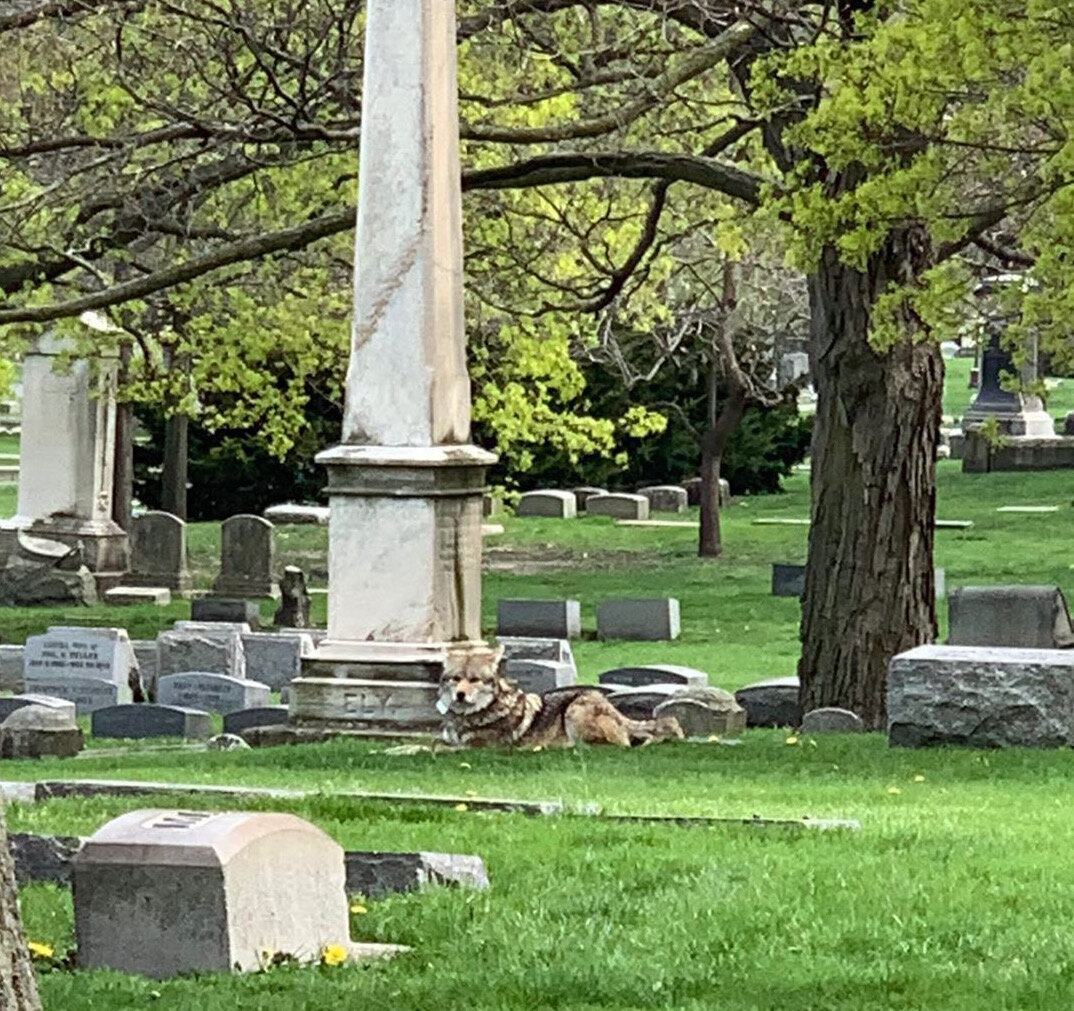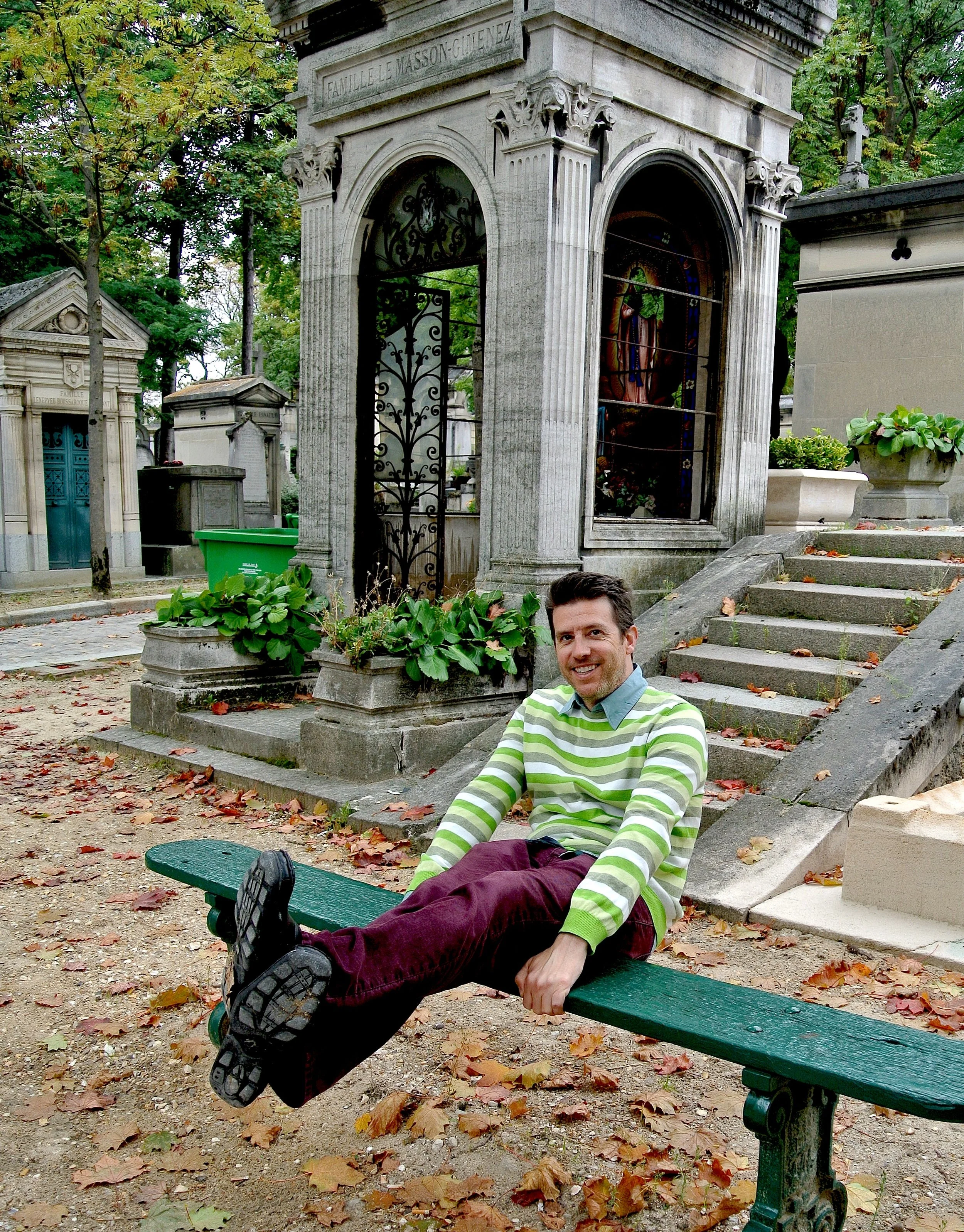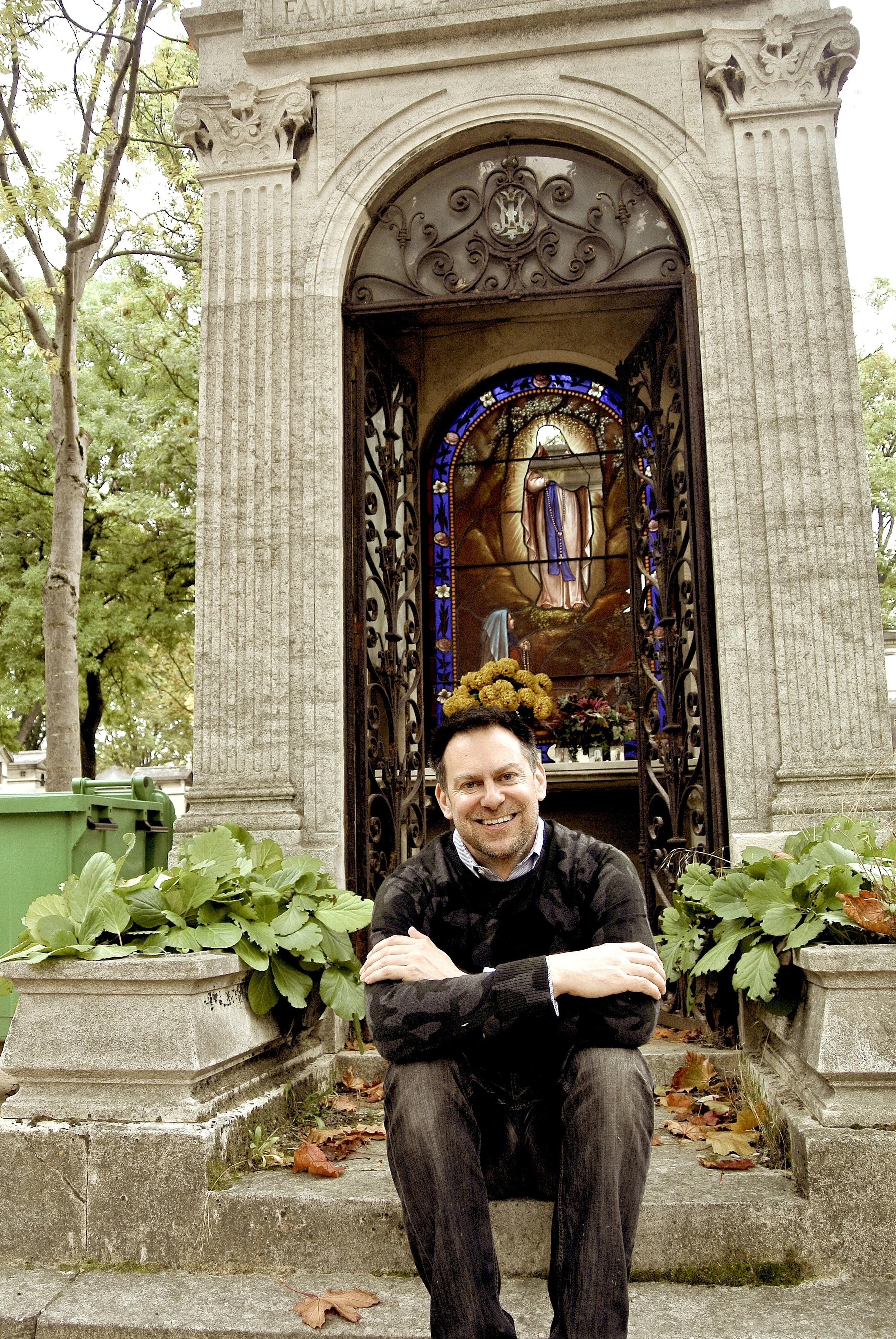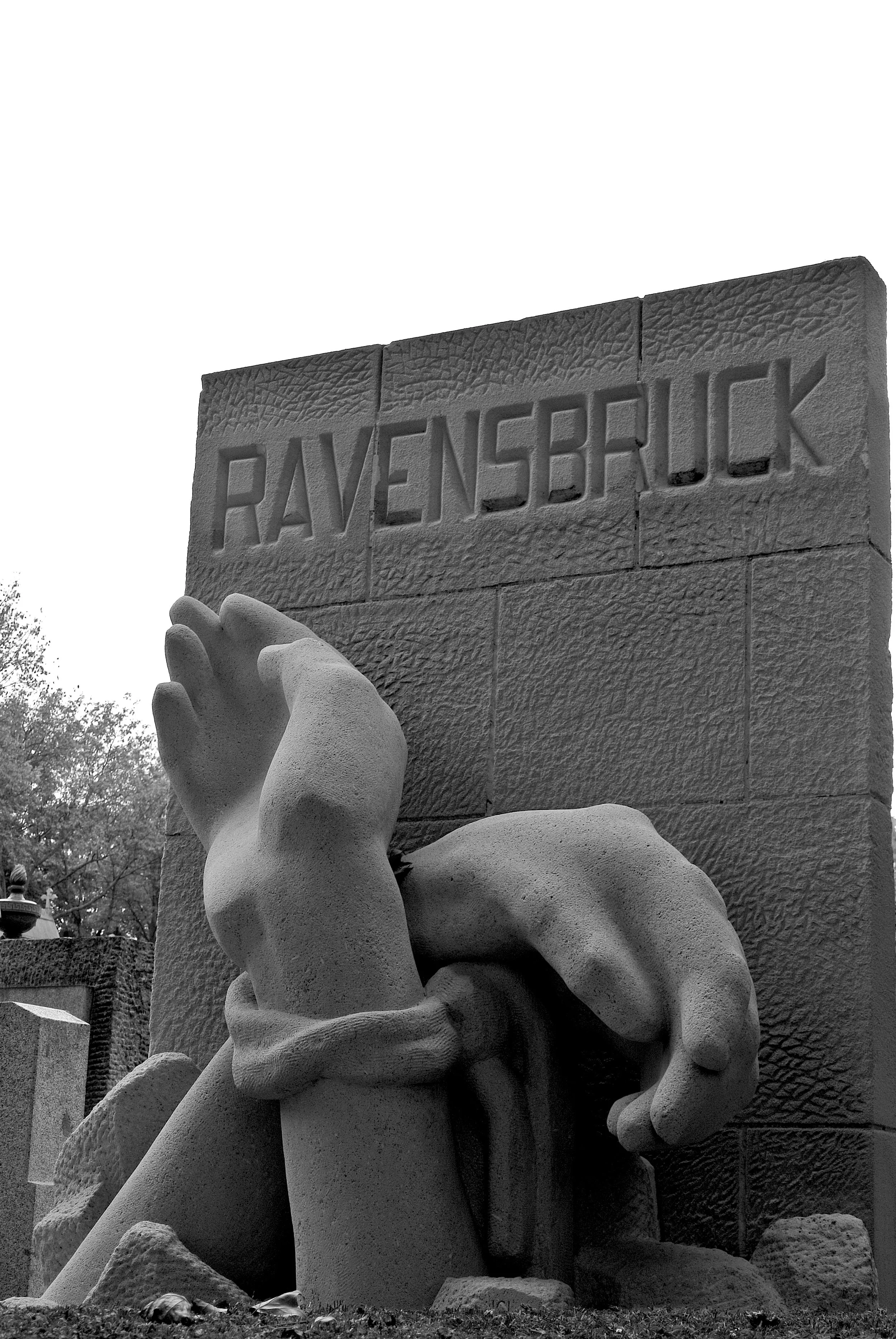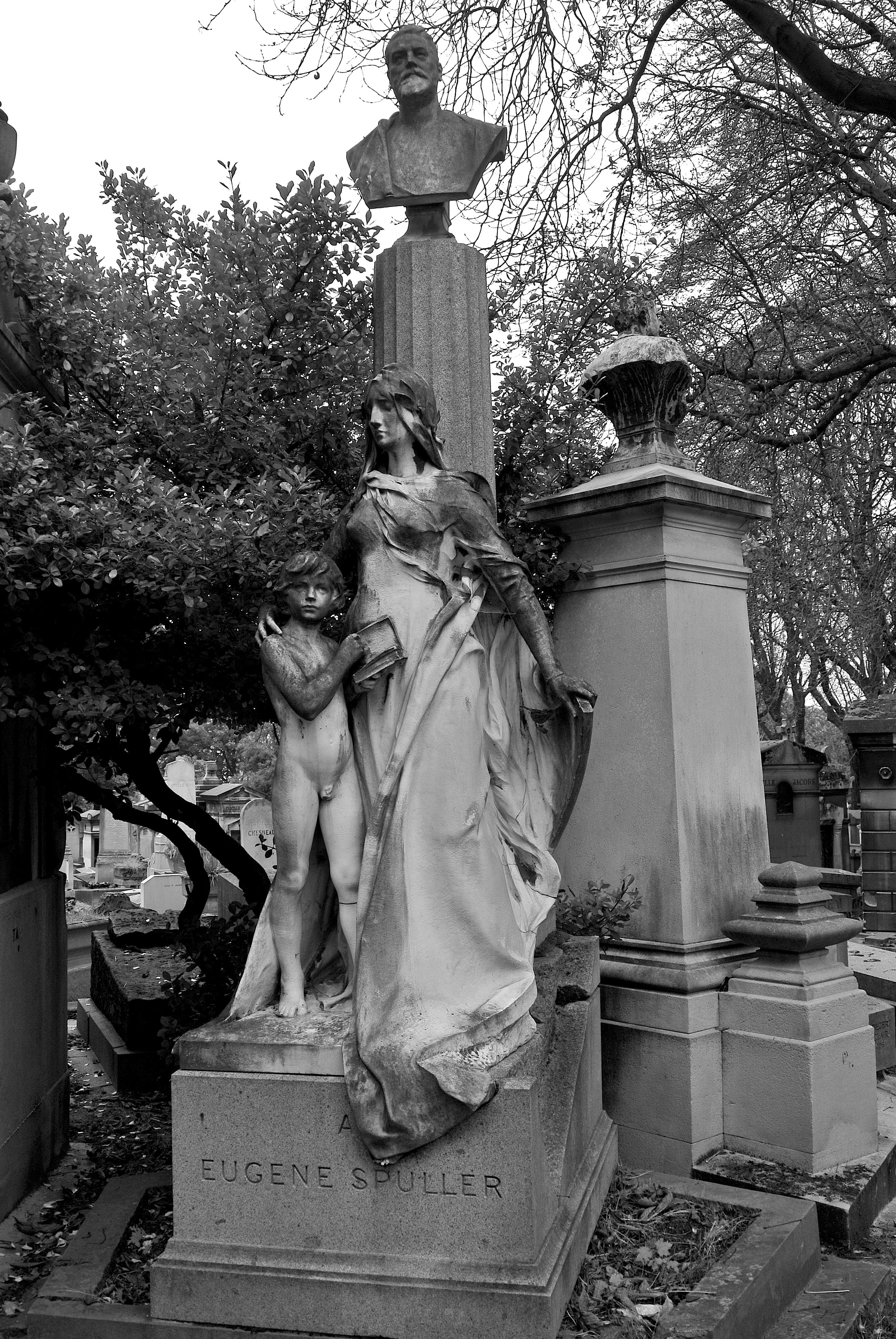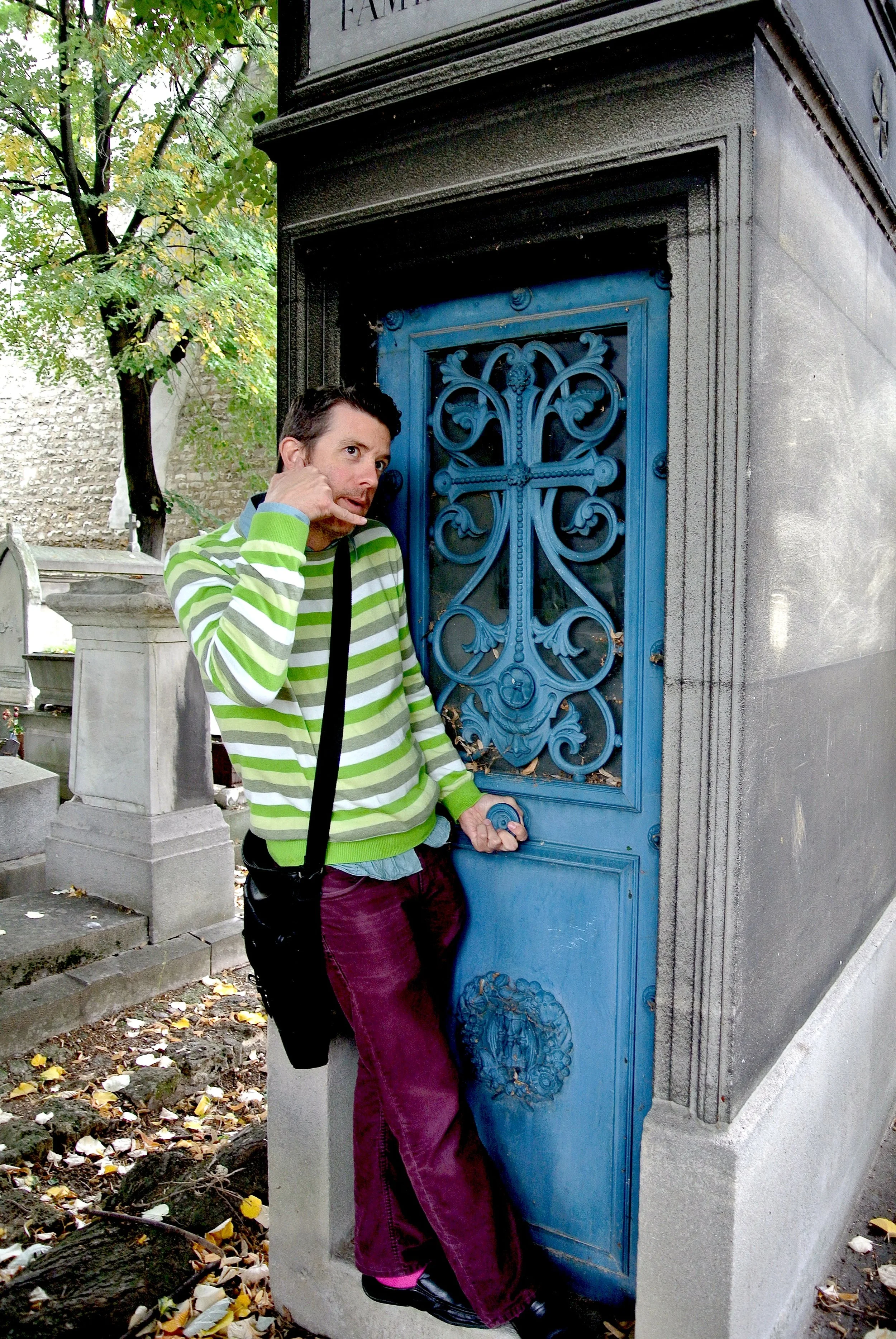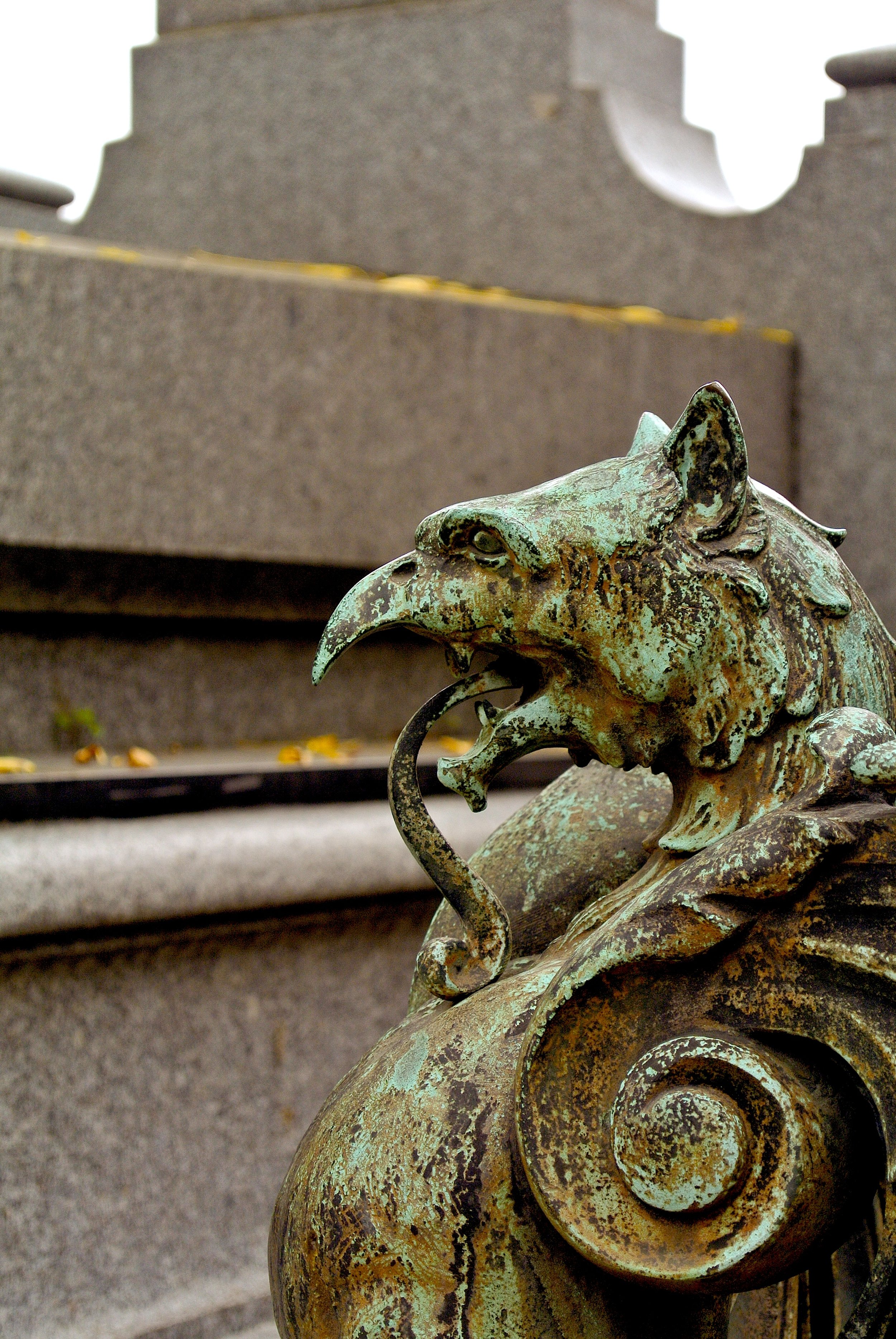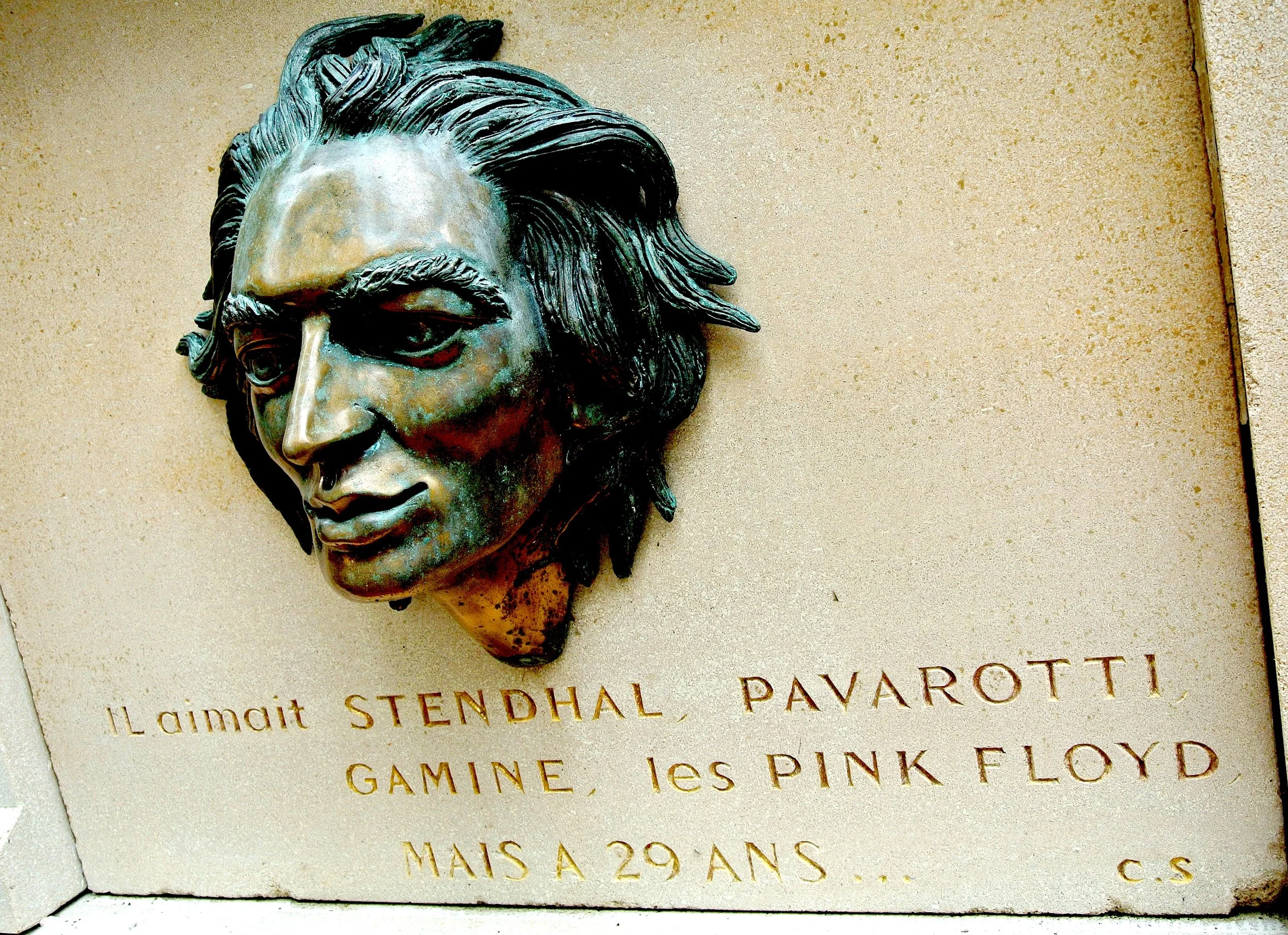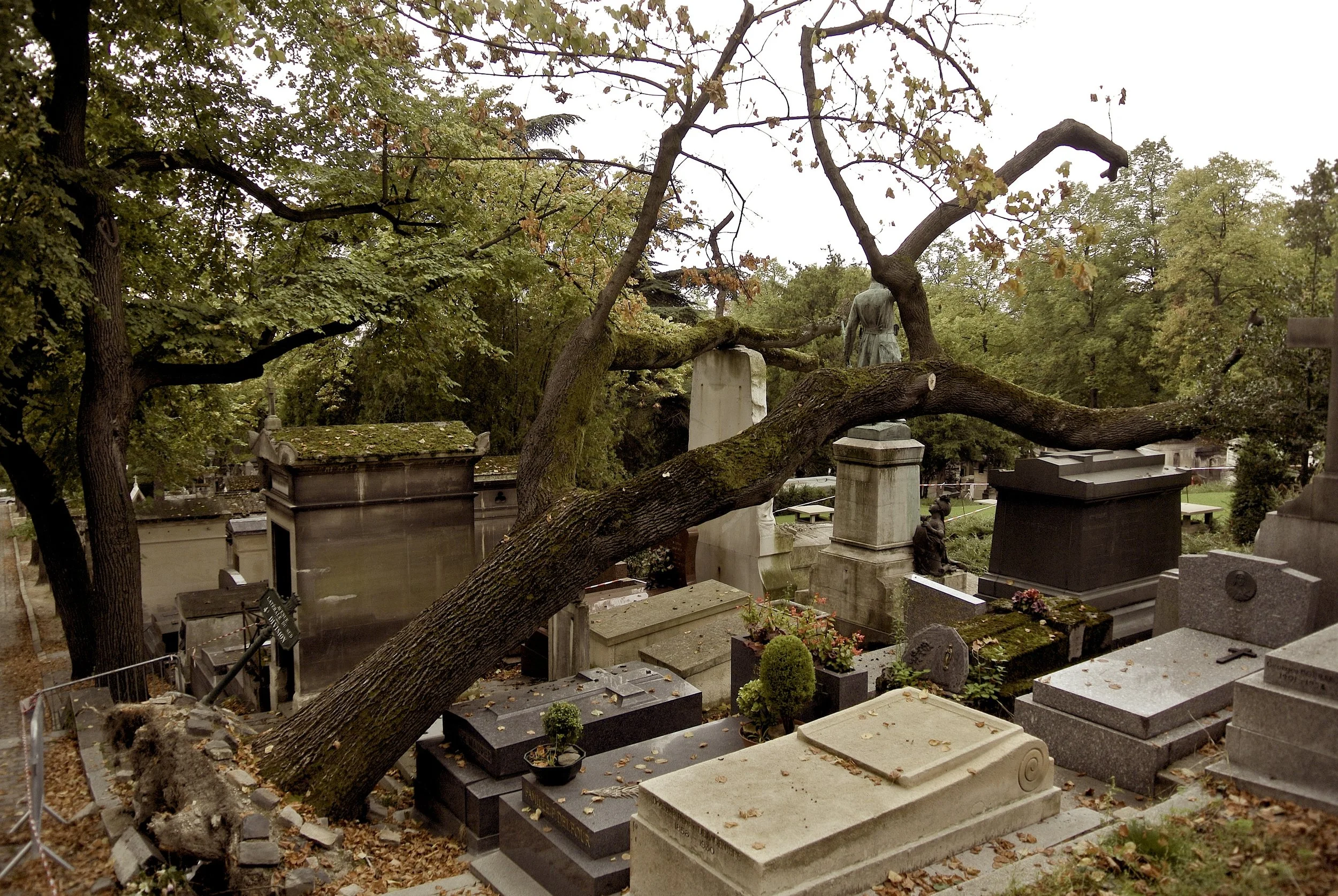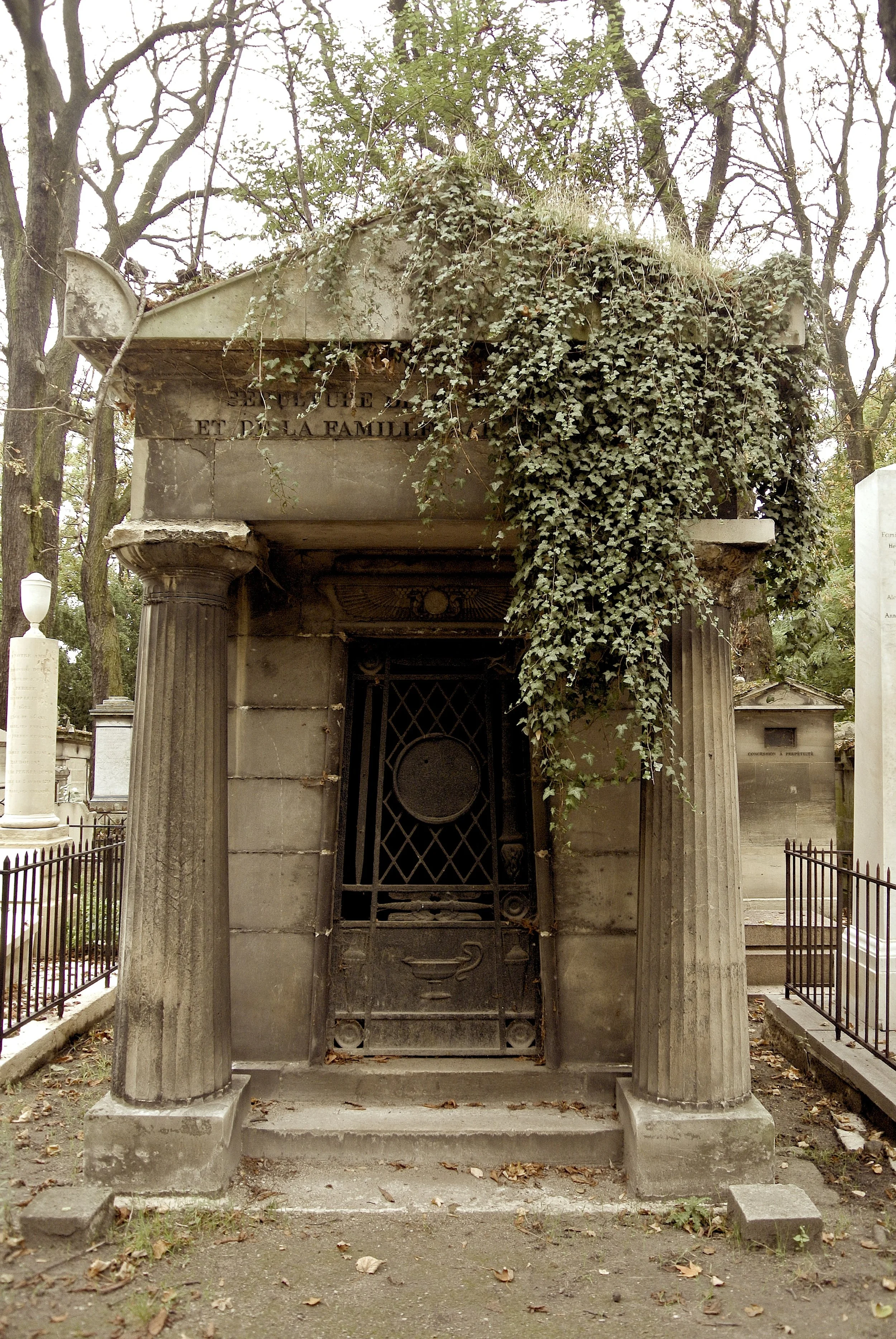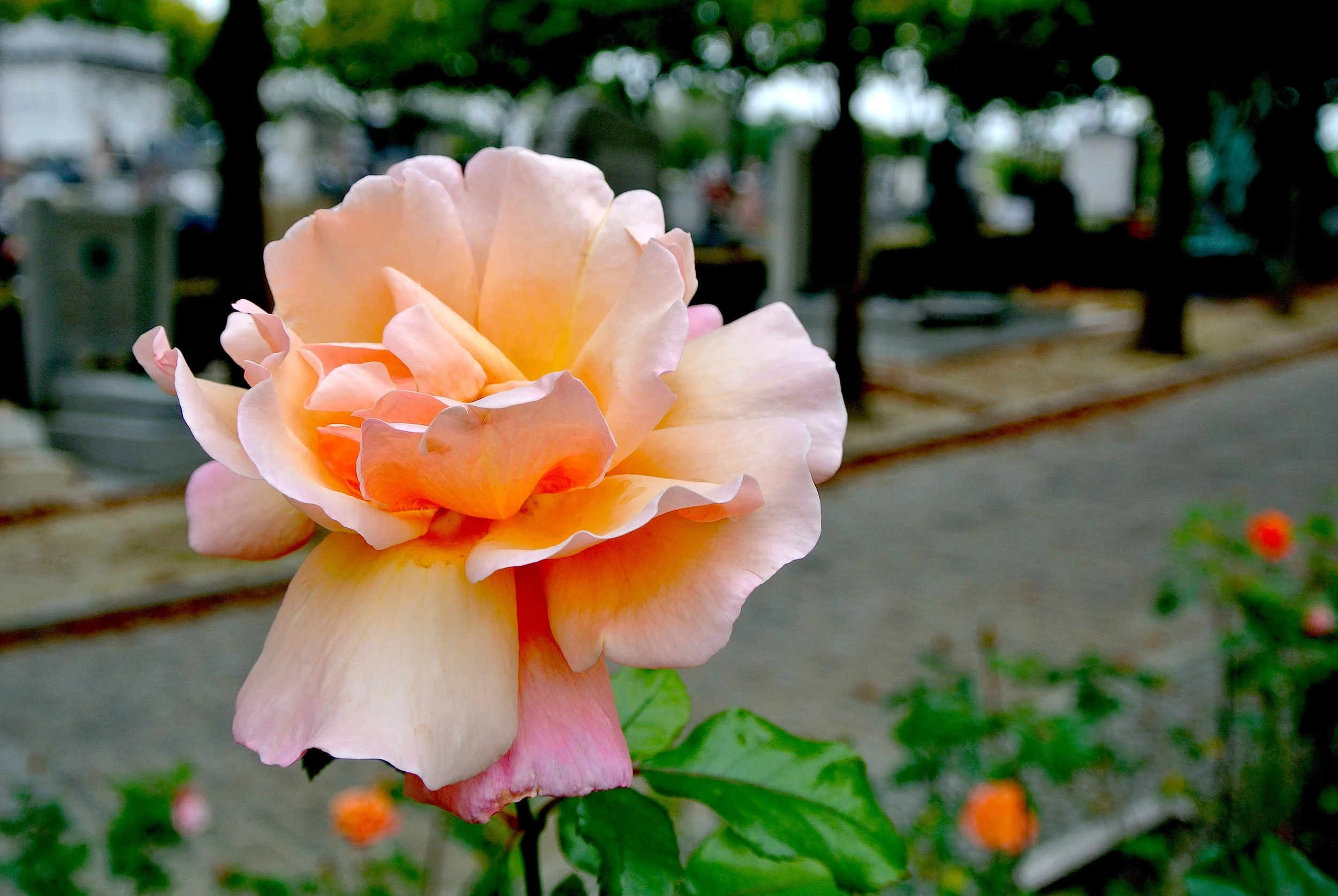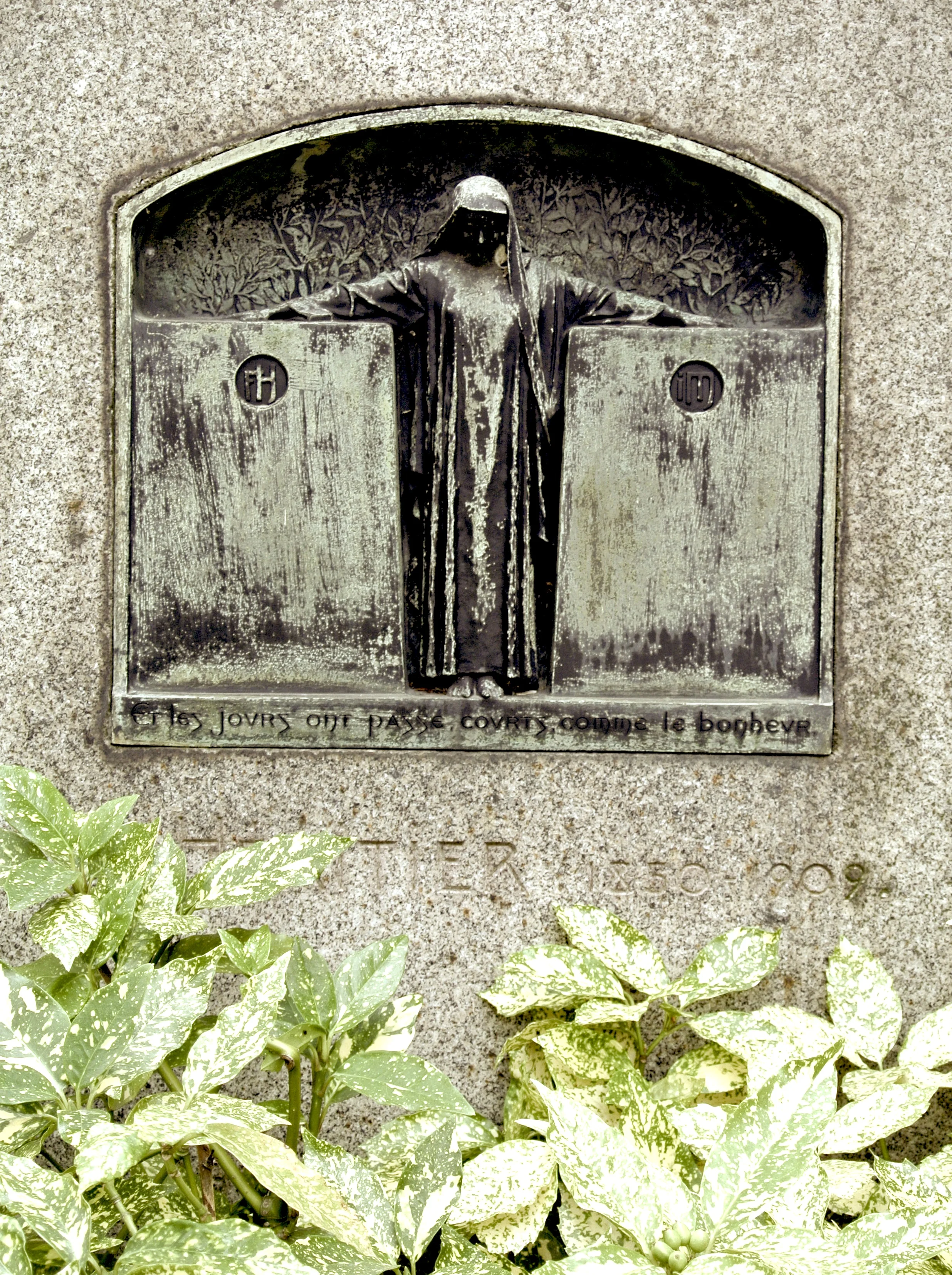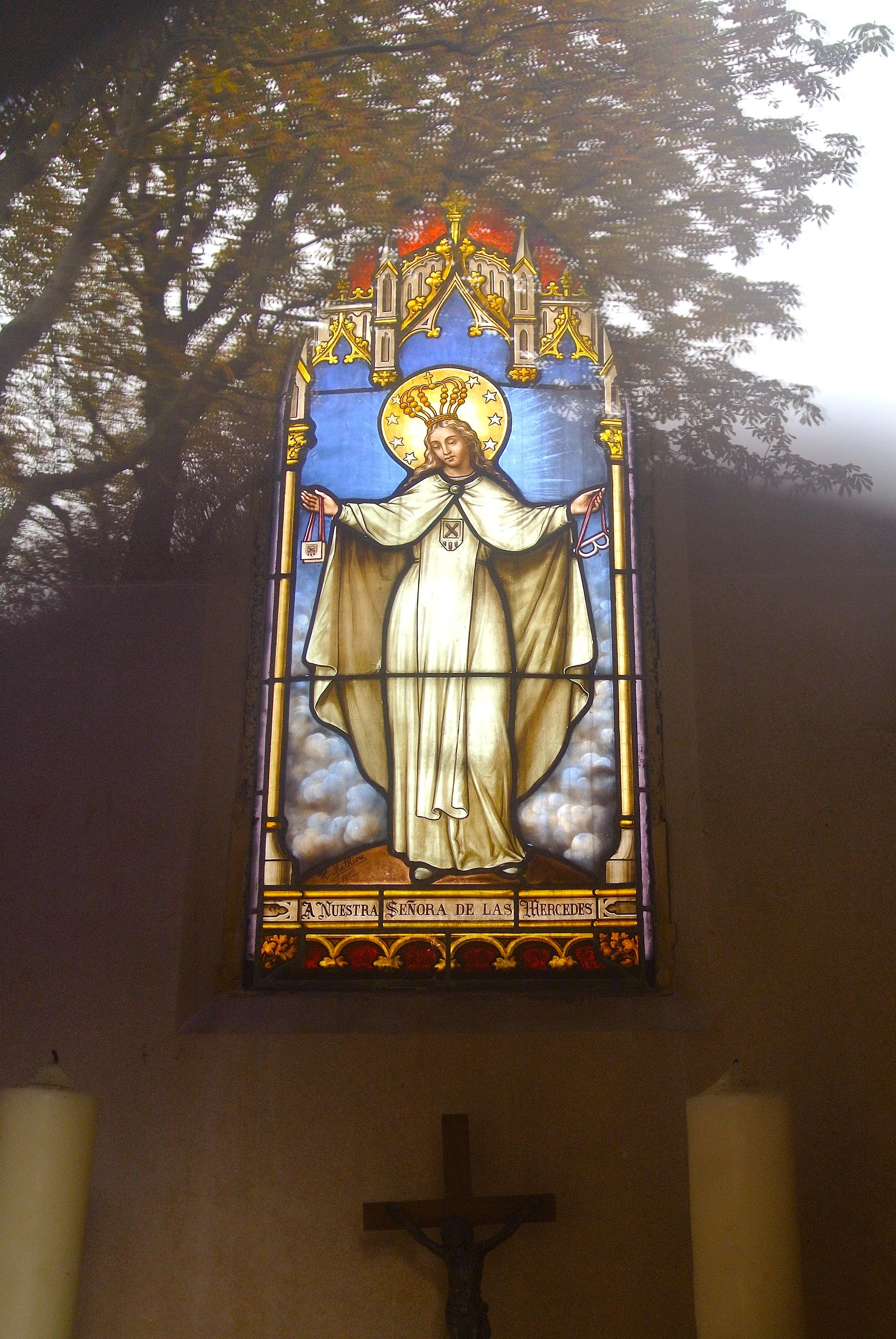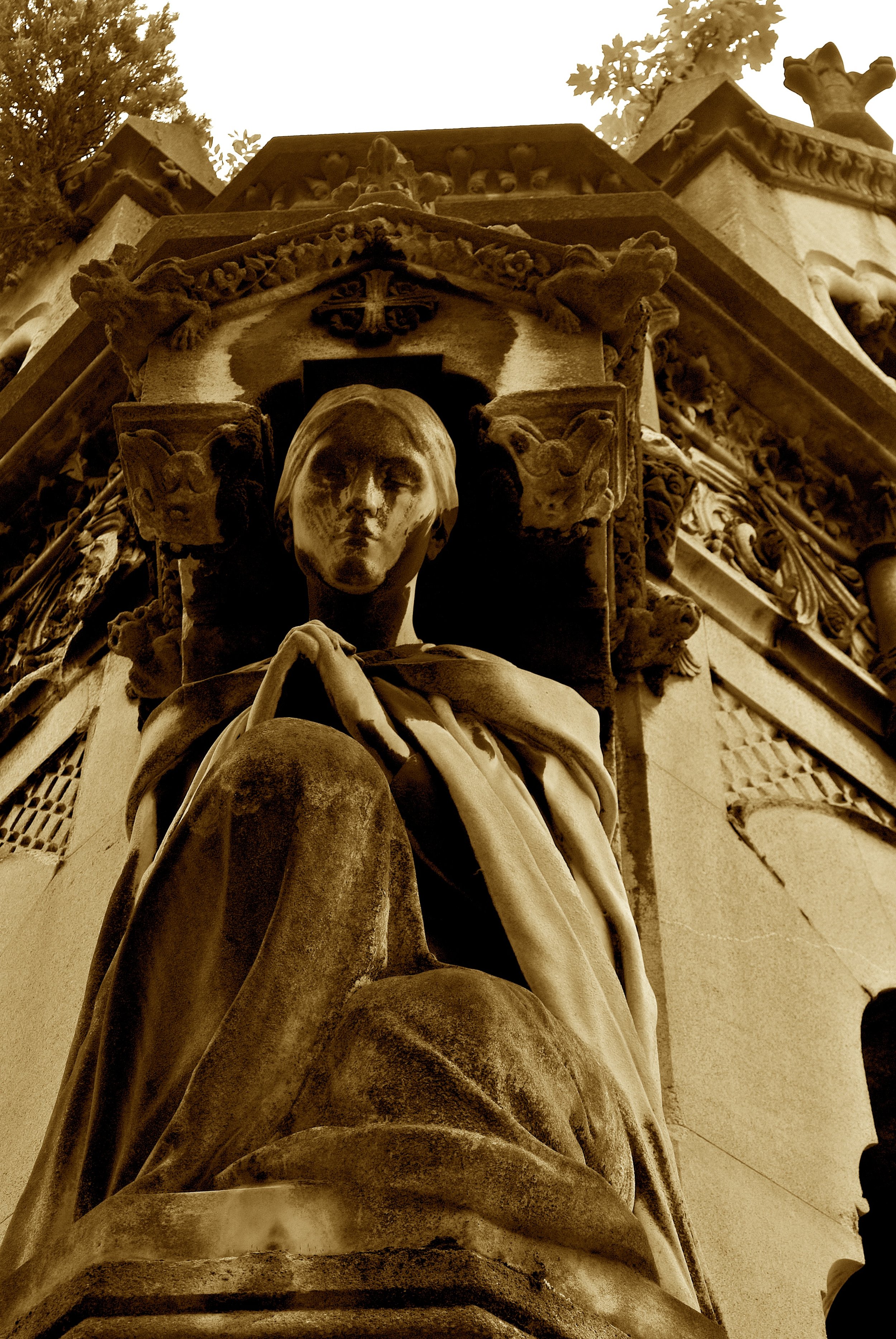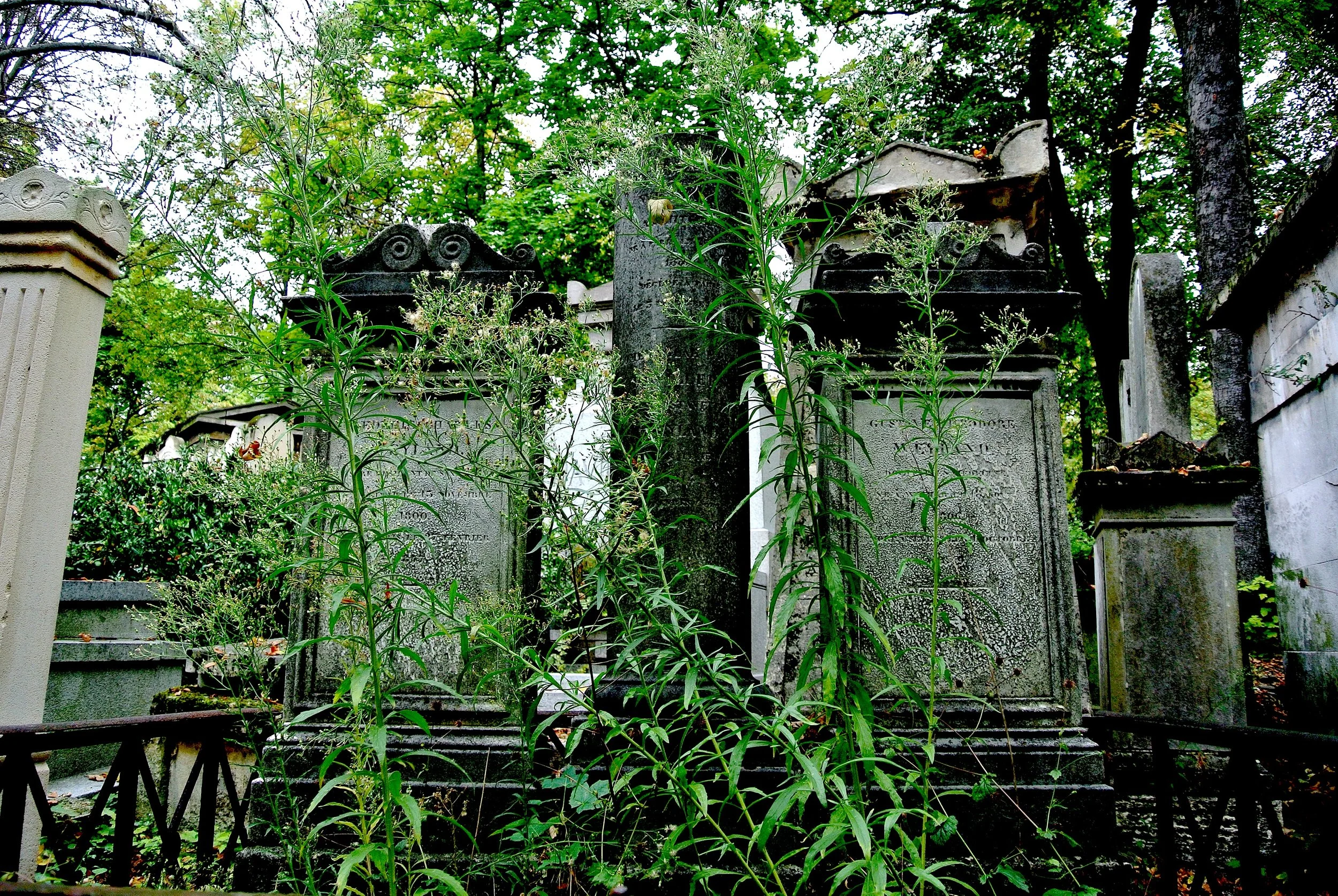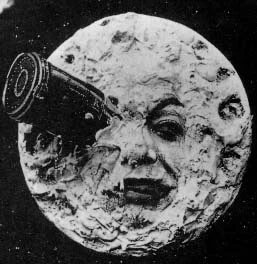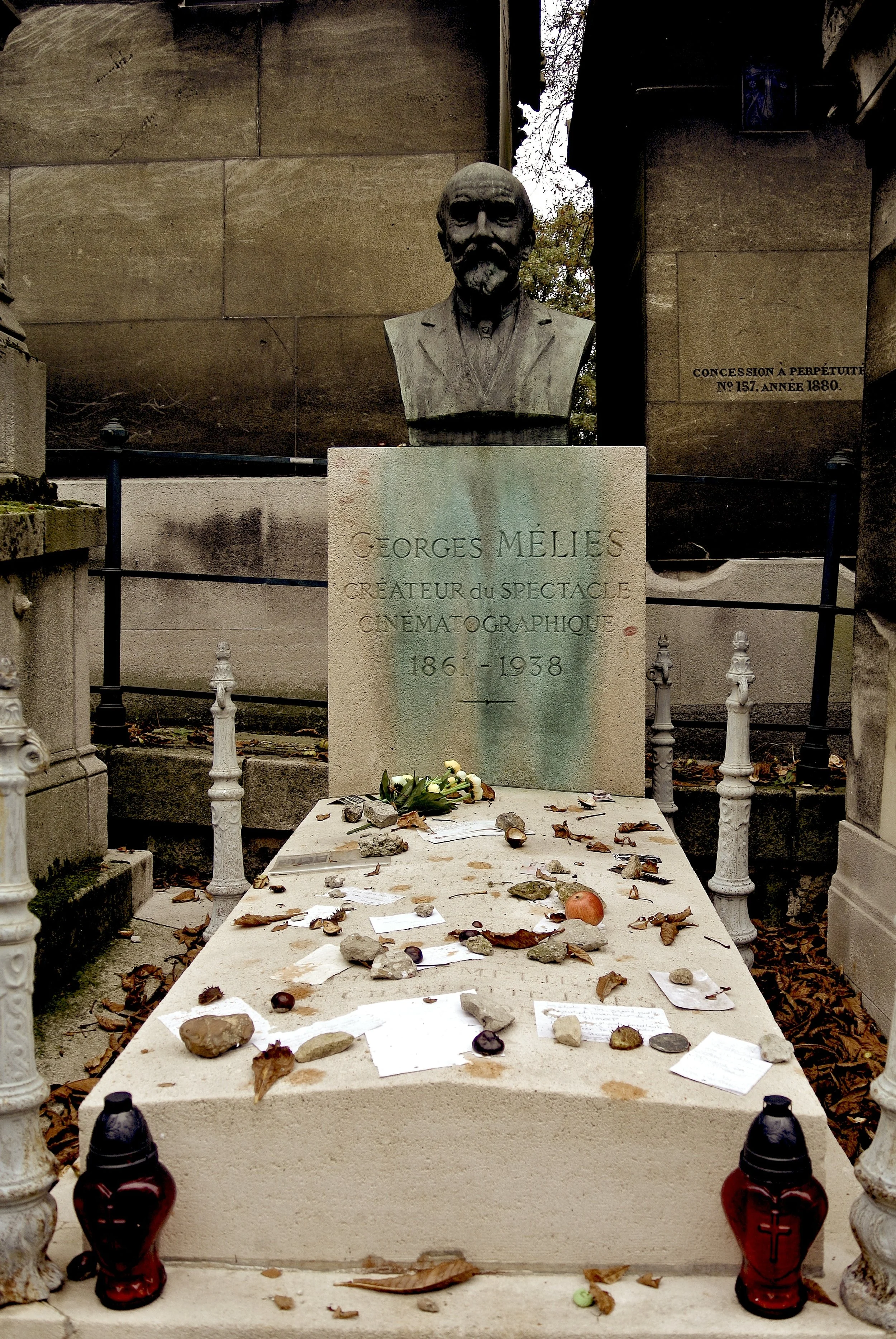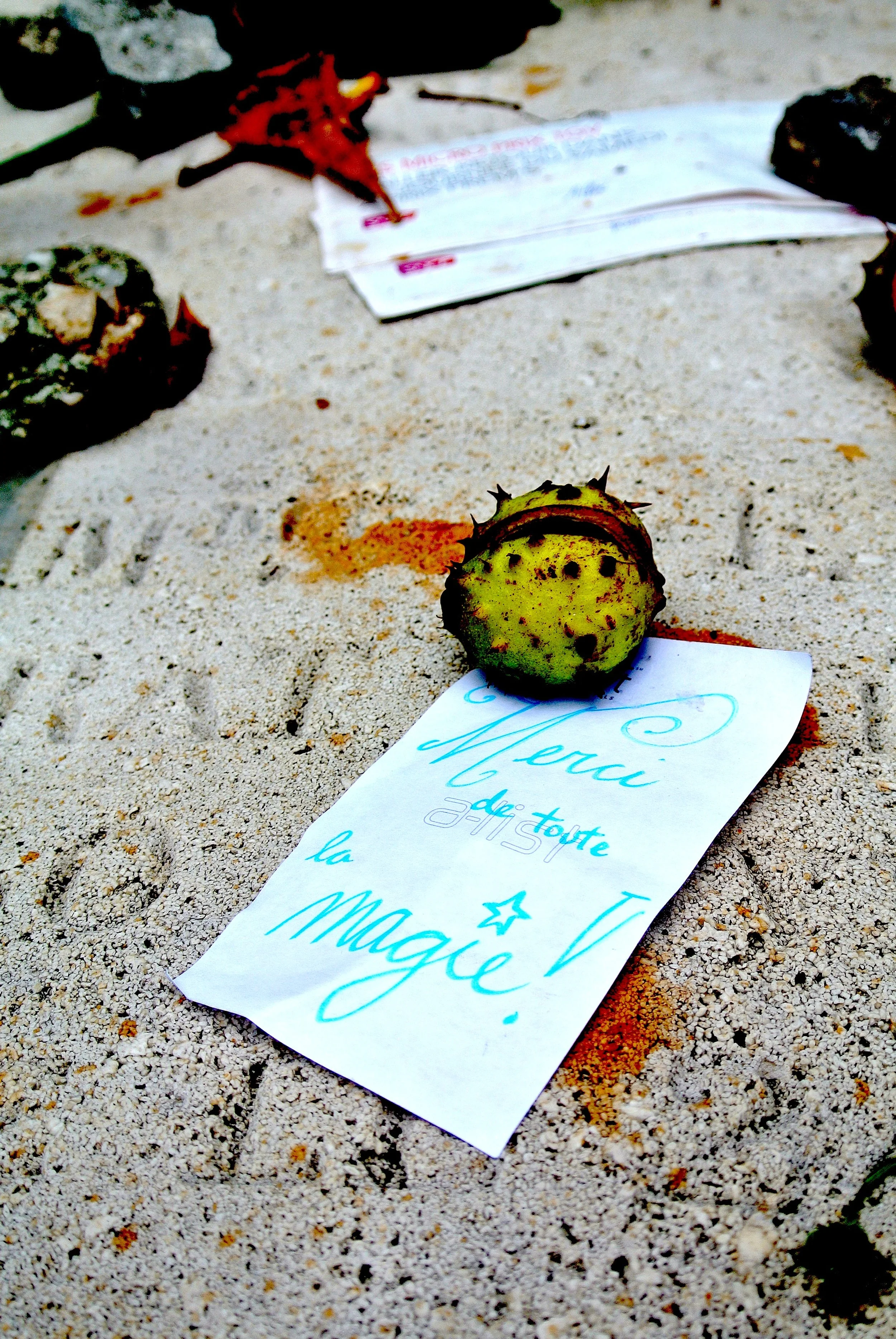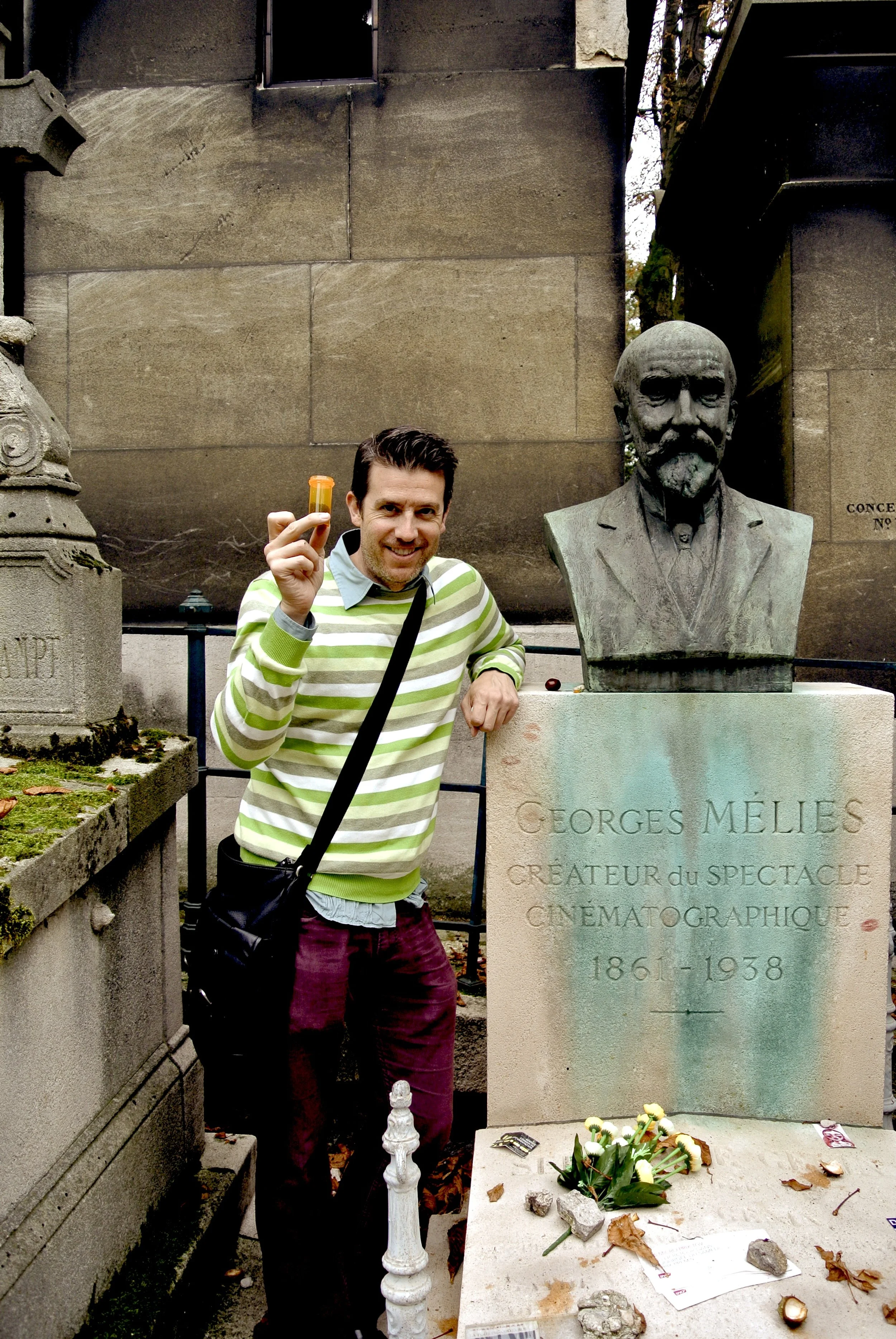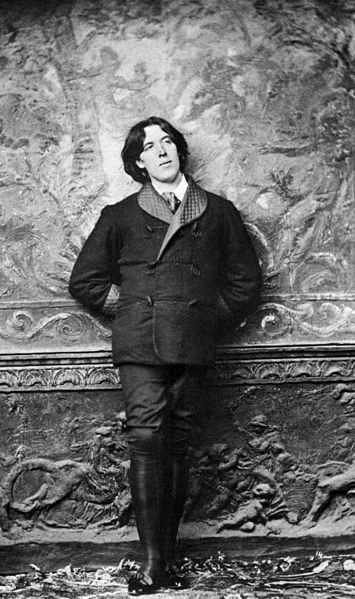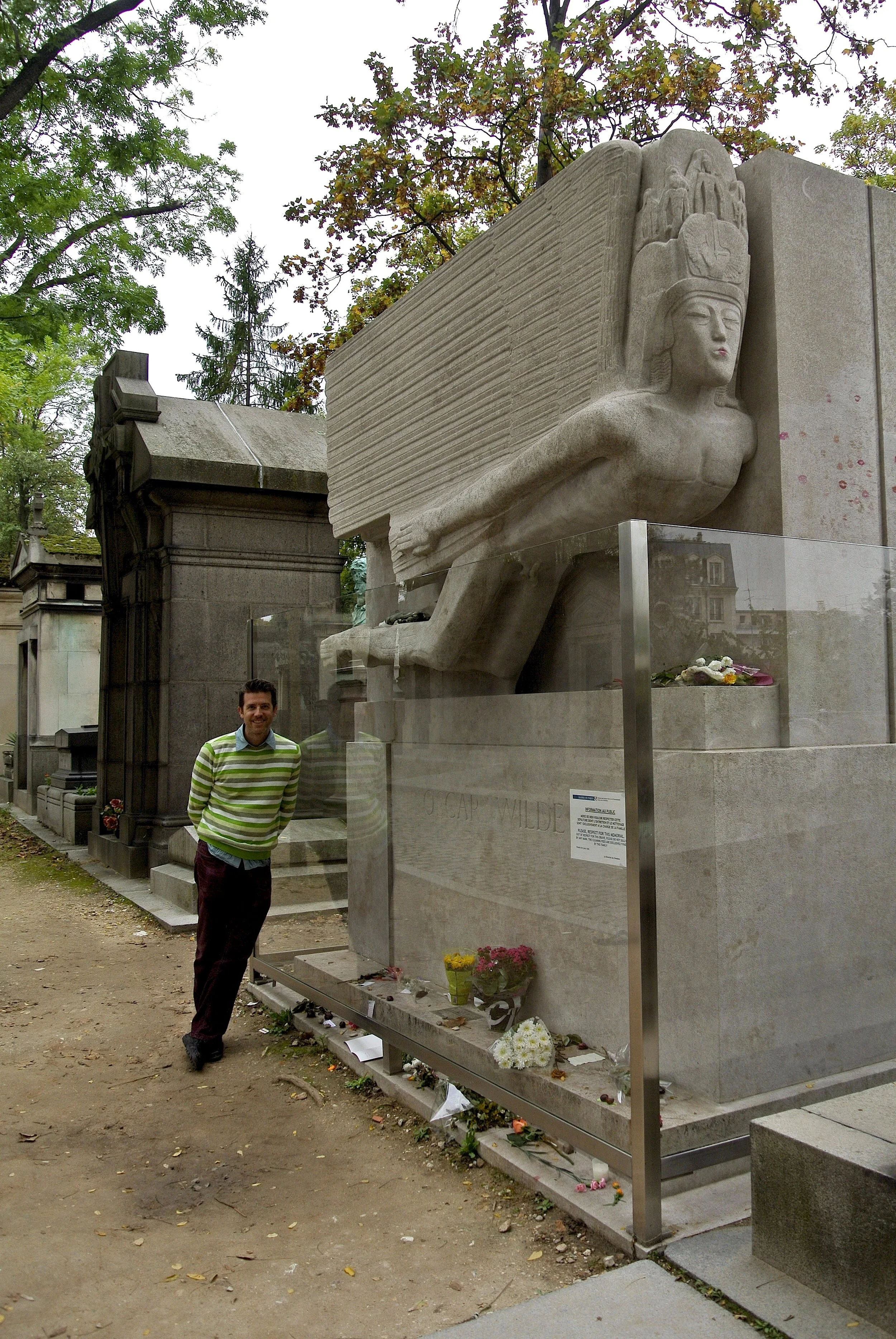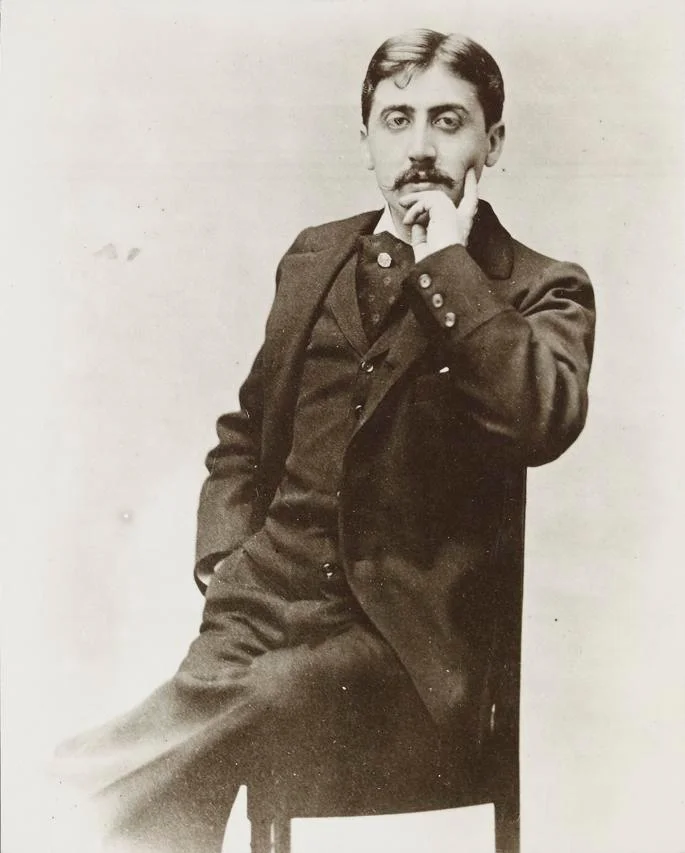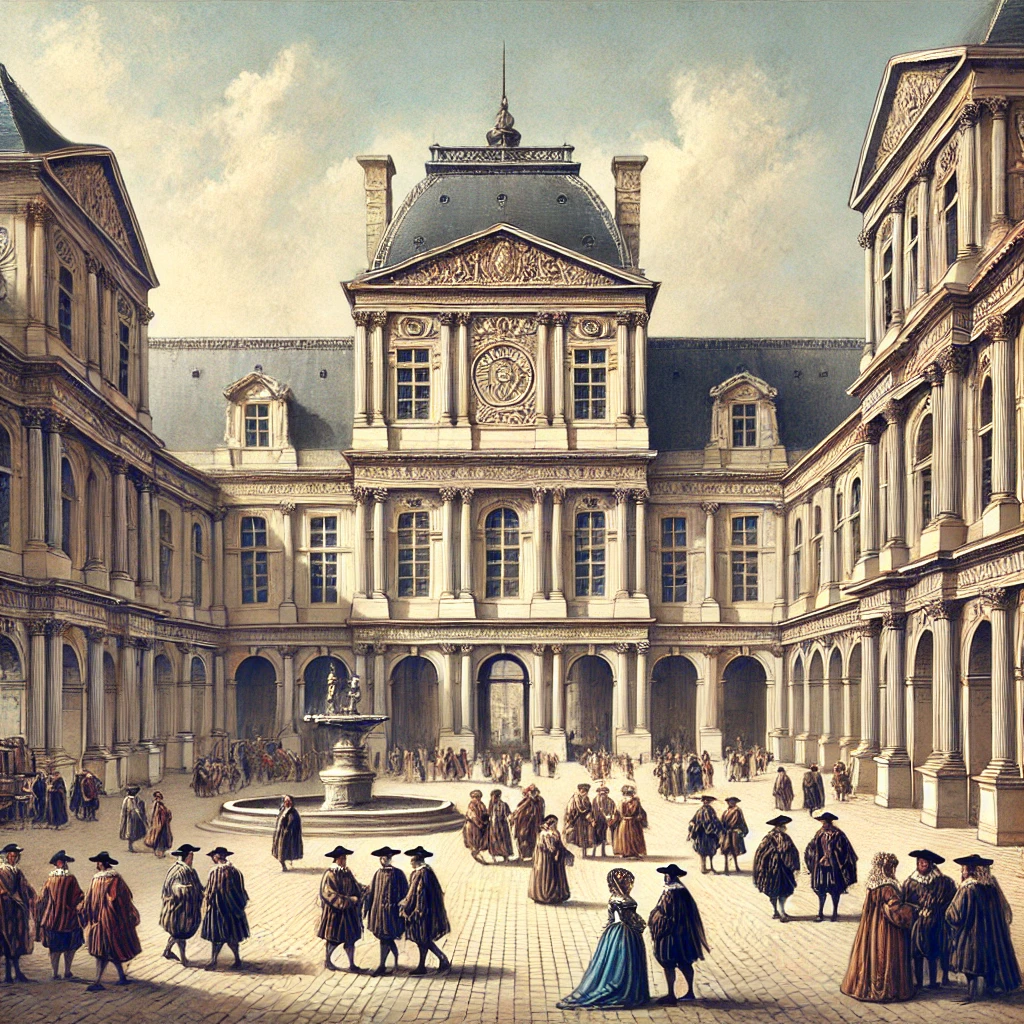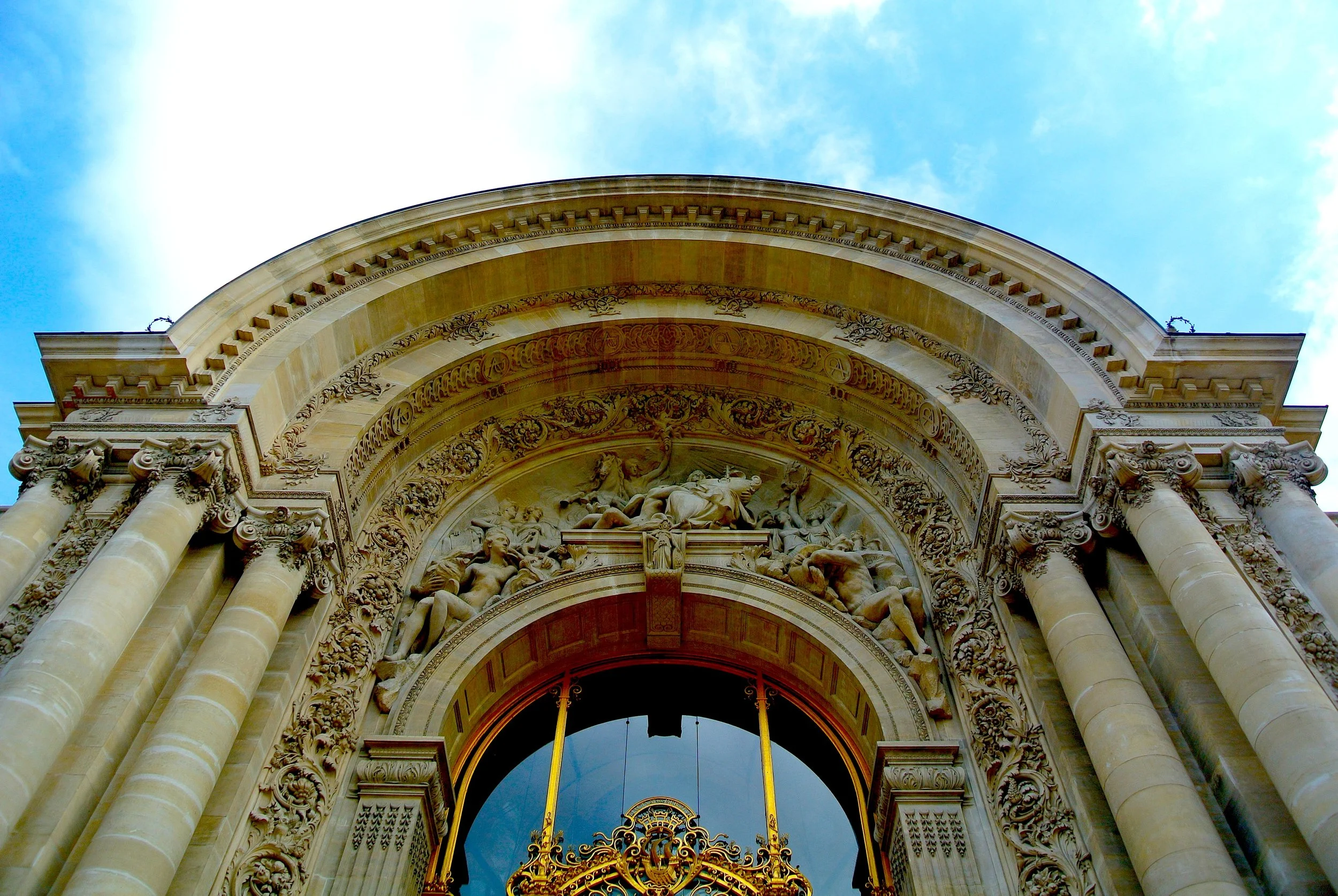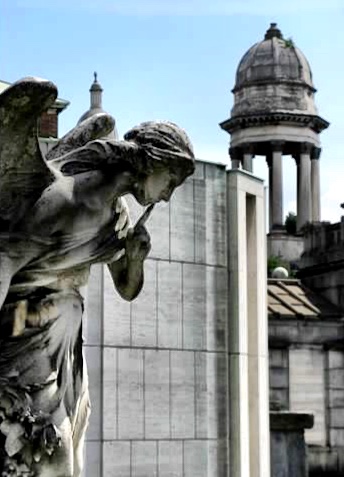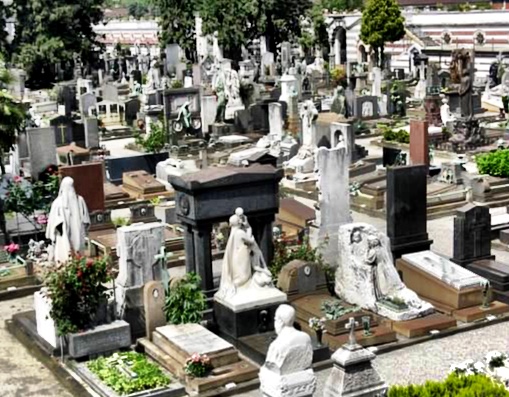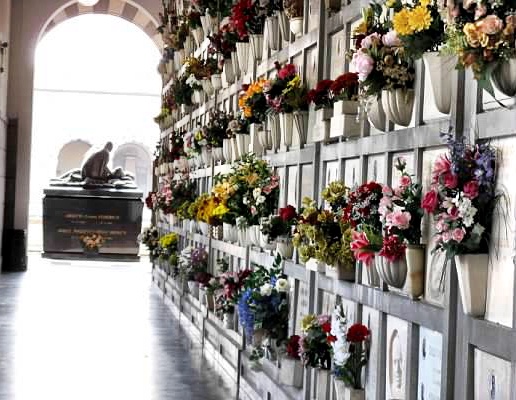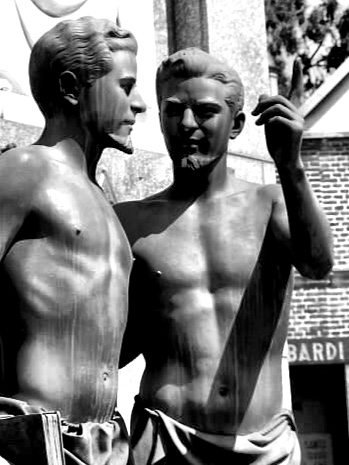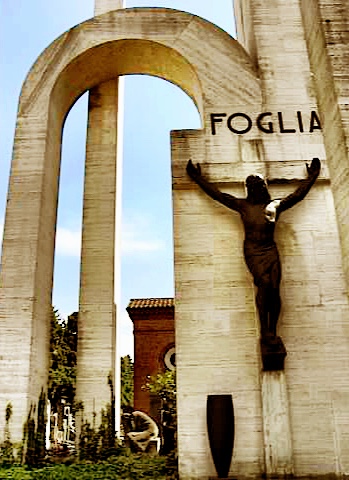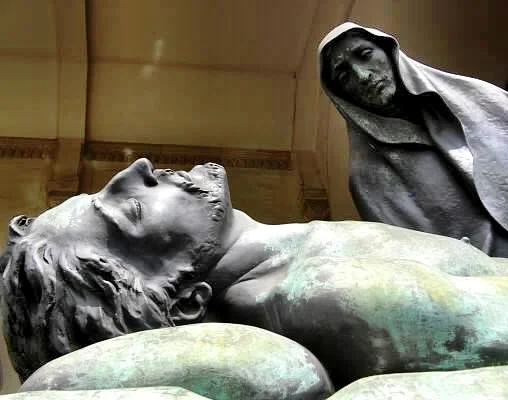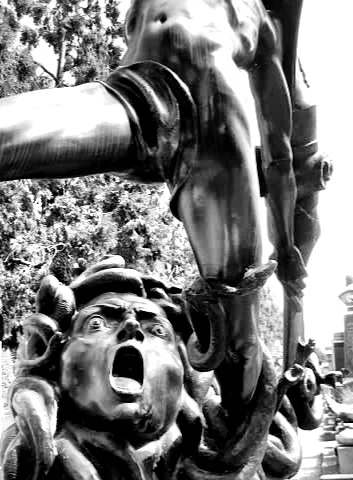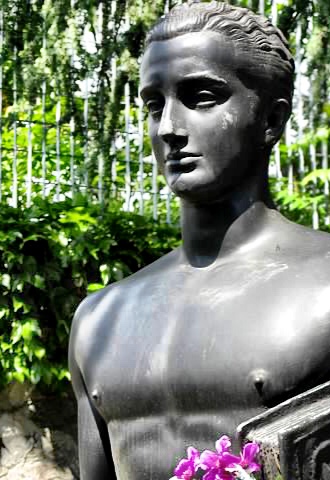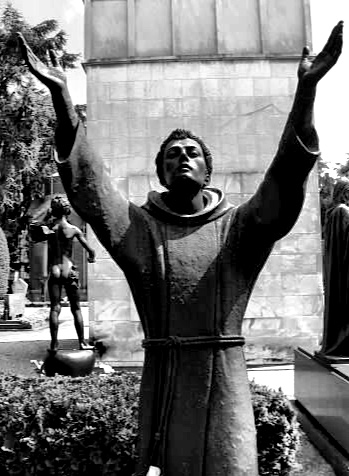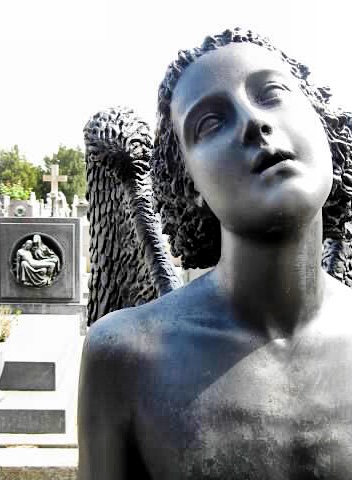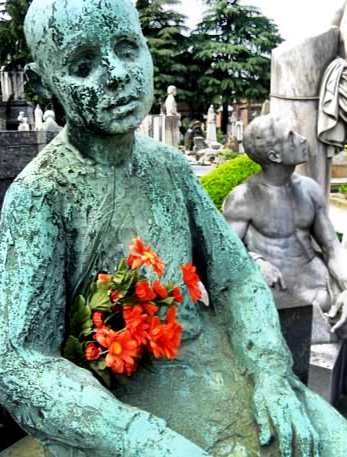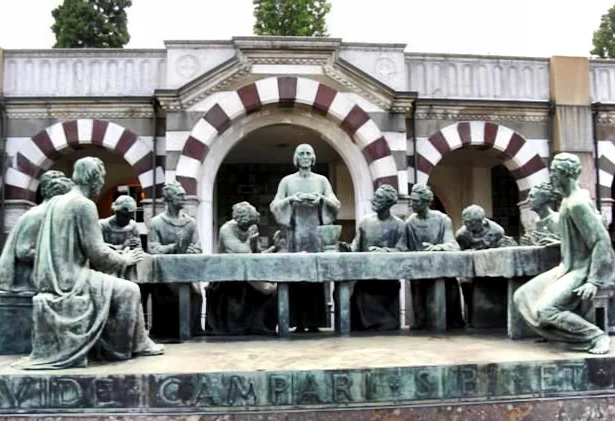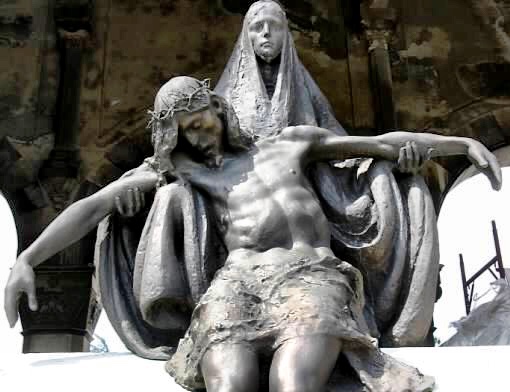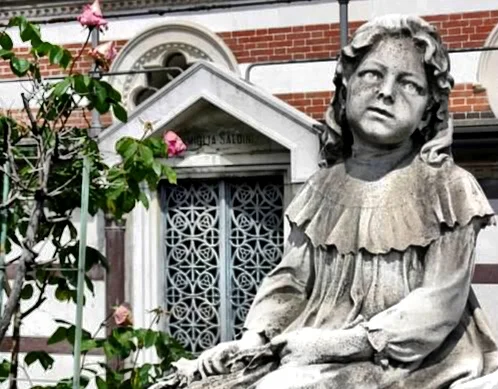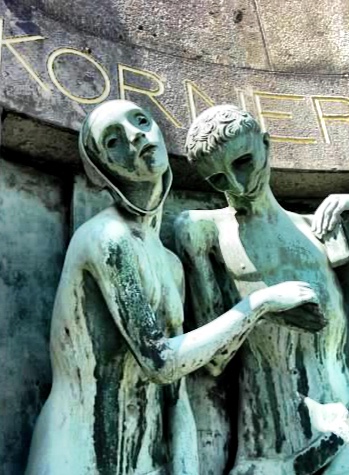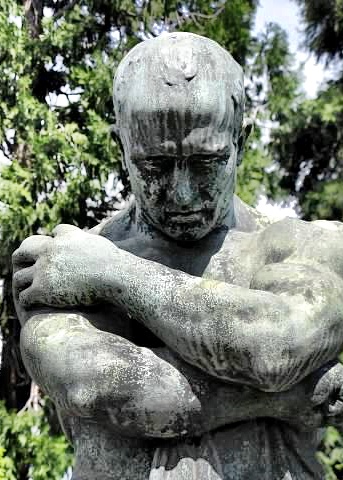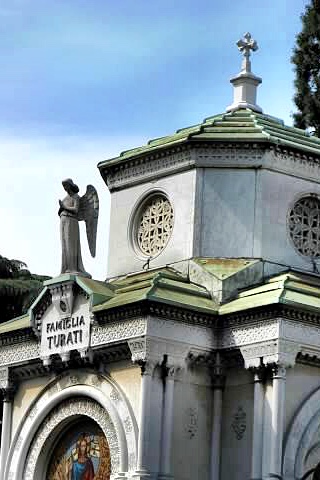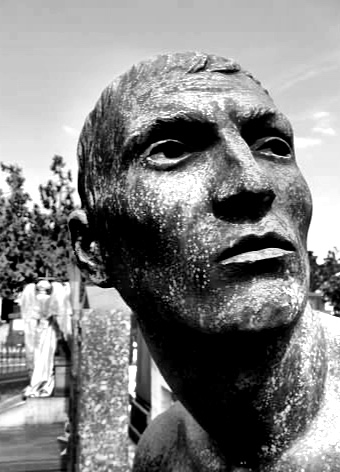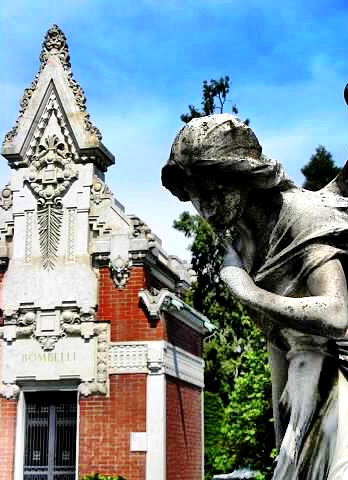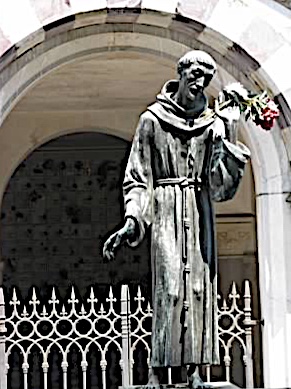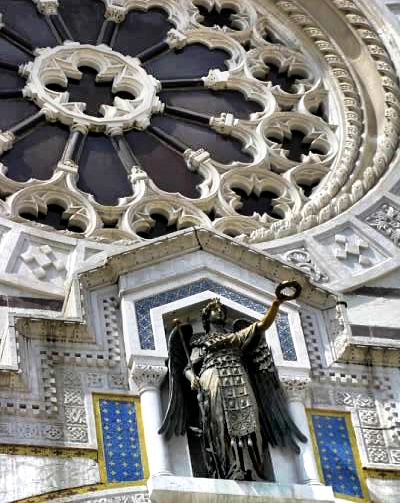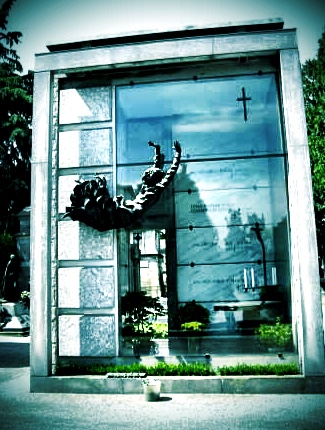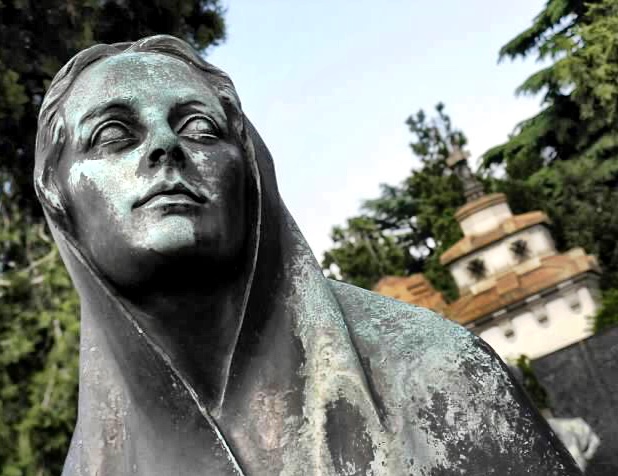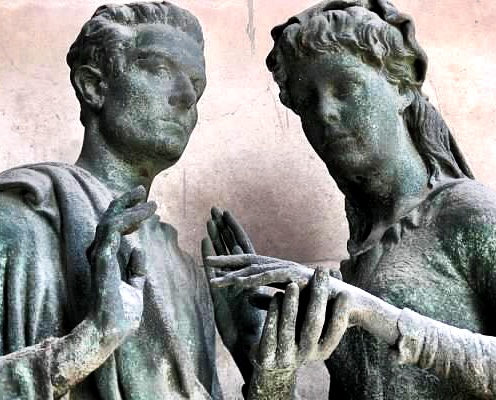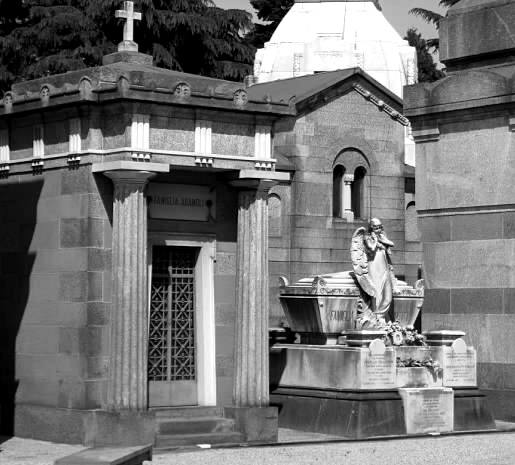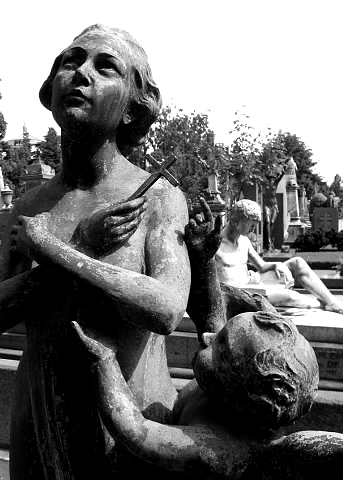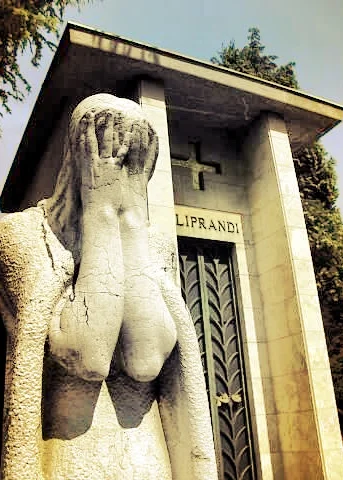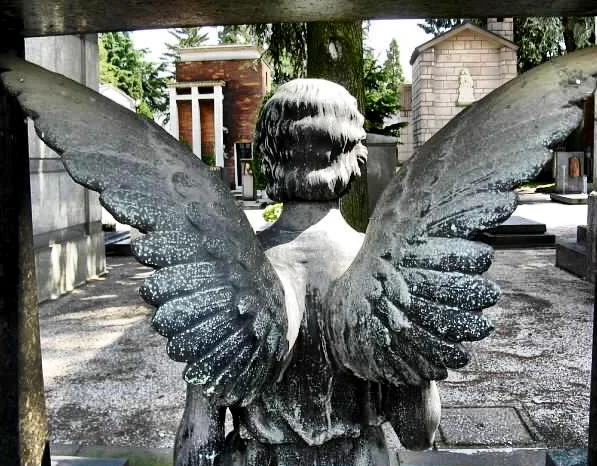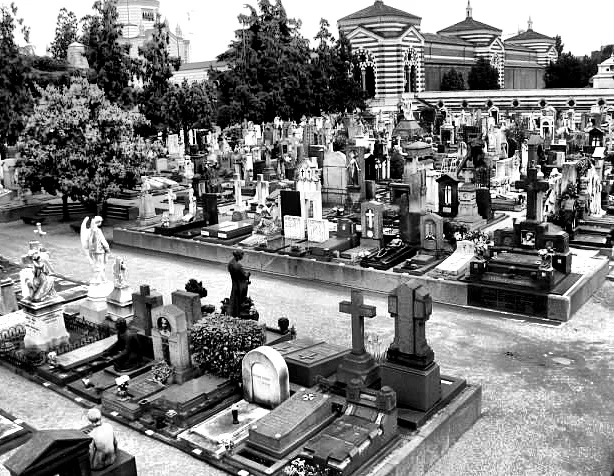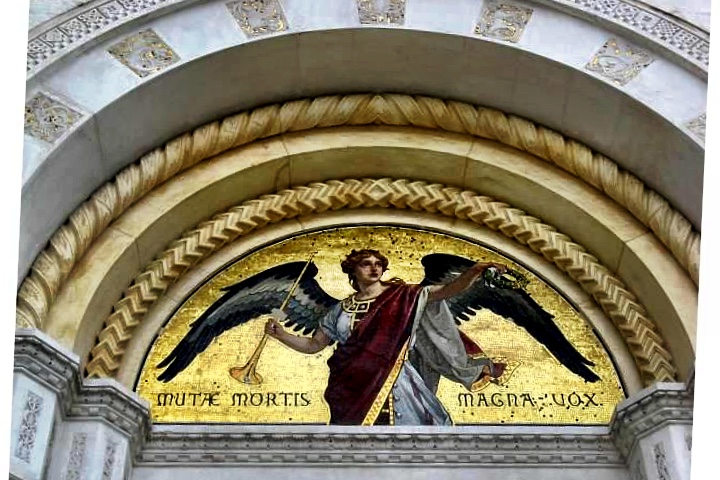Buffalo, New York’s famous resting ground is home to the Blocher Monument and the graves of President Millard Fillmore and Rick James (yes, of “Super Freak” fame).
Wally (and Duke) had a gay old time in Forest Lawn Cemetery — though it was a tough one to navigate on foot.
I’ve always been fascinated by old cemeteries. In college, I taped a set of slides of weathered limestone headstones from the antebellum Laurel Grove Cemetery in Savannah, Georgia, over the diffused light panels on either side of my bathroom’s medicine cabinet. One of the slides showed a tombstone for a little girl, inscribed with the epithet, “Our Little Della.” A few of them were so old and brittle that they were almost translucent.
So, when my husband, Wally, and I were planning our trip to Buffalo, New York, I knew we had to add Forest Lawn Cemetery to our itinerary. I remembered wandering through it many times in my early 20s, when I went to college nearby, and I couldn’t wait to see it again with him, as he shares my appreciation of Victorian funerary art and expansive 19th century parks for the dead.
“She gushed about having seen the grave of Rick James, the singer-songwriter of “Super Freak” fame, an ’80s hit that celebrated a kinky girl — “the kind you don’t take home to mother.””
An add to celebrate Forest Lawn’s 75th year, paying homage to its origins at the site of Judge Granger’s homestead.
The Birth of Forest Lawn Cemetery
Prior to being formally consecrated as a cemetery in the summer of 1850, the land belonged to a man named Erastus Granger. Granger built his homestead and farm on the northernmost parcel, working the tillable parts of the hilly terrain.
He was appointed superintendent of the Six Nations Agency by President Thomas Jefferson where he maintained a close relationship with the Seneca Nation, one of the tribes that occupied the region.
After Granger died, Buffalo attorney William D. Clarke purchased the 80-acre estate from his widow and two sons. Clarke intended to establish a rural garden cemetery on the site, which was a mix of dense forest and meadows. This topography is how the cemetery earned its name, Forest Lawn.
When graveyards were associated with disease, cemeteries were built in rural areas and acted as gorgeous greenspaces.
The Rise of the Rural Cemetery
By the late 1800s, a growing fear of disease led to a change in the way people thought about death and burial. Cramped and overcrowded church graveyards were seen as unsanitary and as a threat to public health. People began to seek out more peaceful and bucolic settings for their loved ones’ final resting places, which led to the rise of the rural cemetery movement.
The location of these cemeteries was often outside city limits for both hygienic and aesthetic reasons. They were beautiful greenspaces, with forested groves, meandering footpaths and elaborate monuments. One of the most famous examples is Père Lachaise in Paris, France. Founded in 1804, it quickly became the blueprint for many others.
As cities expanded, rural cemeteries like Forest Lawn were swallowed up by urban sprawl. Although they were no longer considered “rural” in the traditional sense, they retained their pastoral beauty and tranquil atmosphere.
The monument to Seneca Nation chief Sagoyewatha, also known as Red Jacket, stands atop a column inside the Delaware Ave entrance. He got his nickname from the red wool British infantry coat he wore during the American Revolution.
Famous Graves: Millard Fillmore and Friends
Forest Lawn has its share of famous residents, including: Millard Fillmore, the 13th president of the United States; John J. Albright and Seymour H. Knox, the founders of the Albright-Knox Art Gallery; Red Jacket, the orator and chief of the Seneca Nation, who supported the neutrality of his nation during the War of 1812; and George Norman Pierce, the creator of the Pierce-Arrow Motor Car.
But Wally and I were more interested in seeing a few of the more unusual monuments of its permanent residents.
These eight bells were originally part of a set of 43 that was forged in Le Mans, France and hung in the steeple of St. Joseph’s Cathedral.
For Whom the Bell Tolls
Our first stop was an impressive steel structure holding eight verdigris copper and tin alloy bells. The carillon, located near the main office and wrought iron gates of the Delaware Avenue entrance, has a fascinating history.
The largest of the group is the Oishei Memorial Bell, dedicated to the late businessman and philanthropist John R. Oishei (pronounced “Oh-shy”). It sits upon an elaborate marble plinth that was taken from the demolished St. Joseph Cathedral, which once stood at the corner of Delaware Avenue and Utica Street. This particular bell weighs in at 1.5 tons (3,000 pounds), and is a testament to the craftsmanship of Bolée et Fils, the French foundry that cast them in 1866.
The Oishei bell's surface bears the Latin inscription “Laudate Dominum Omnes Gentes,” which means “Praise the Lord, All Ye Nations” — more commonly known as Psalm 117. Note the gargoyles guarding the top of the bell.
The eight bells were originally part of a 43-bell set commissioned by John Timon, the first bishop of the Roman Catholic Diocese of Buffalo. They were intended to hang in the bell tower of St. Joseph’s Cathedral on Franklin Street — but by the time they arrived in Buffalo, Bishop Timon had died. The bells were installed in the belfry, but were too large for its interior and never worked properly. They were eventually removed and put in storage, where they remained until the new St. Joseph Cathedral was built.
Although the new cathedral was larger and more grand than the previous cathedral, its marble-clad exterior was ill-suited for harsh Buffalo winters. By 1924, the north and south transepts required major repairs, and by 1927, the towers were so unstable that they had to be removed. The bells were once again placed into storage, this time in the sanctuary’s basement. Over the next 48 years, 35 of the original 43 bells were stolen, leaving only eight.
The second incarnation of the cathedral was demolished, but Michael Dozoretz of Lancaster Steel Service Company salvaged the remaining bells. The aforementioned largest of these was purchased by Patricia Colby-Oishei and given to Forest Lawn Cemetery in 1975 to commemorate her father.
Oishei made his fortune by perfecting and marketing wiper blades for cars, which had not yet been widely used in 1916. He founded Trico Products Corporation, which still specializes in integrated windshield wiper systems today. The bell is also a testament to the generosity of the Oishei family, who have donated so much to Buffalo's cultural and charitable institutions.
The seven additional bells were donated by Dozoretz and suspended from the graceful metal frame above the Oishei Memorial Bell in 2020. They ring on the hour and play the De Profundis, a Latin adverb meaning “Out of the Depths of Sorrow,” as funeral processions enter the cemetery grounds.
The lavish Blocher Monument (located in Section 11), is hard to miss. Look inside: It depicts Nelson Blocher, son of John and Elizabeth Neff Blocher, in repose. Above his head, a scantily clad angel beckons him to Heaven.
Blocher Monument: A Tragic Tale of Love and Loss
Our next stop was the Blocher Monument, one of the most unusual and elaborate memorials in Forest Lawn Cemetery. Architecturally speaking, it resembles a folly, or perhaps a mechanical clock, ready to spring to life. The towering structure is topped by a fanciful two-tiered bell-shaped affair that reminds me of the pink cable knit hat worn by the cartoon character Dumb Donald on The Adventures of Fat Albert, complete with a pompom on top. It reportedly weighs 29 tons, is supported by five pilasters, and is enclosed in plate glass. (I almost don’t even want to tell you what Wally thought it looked like. Oh fine: He called it the Butt Plug.)
There are three crypts beneath a moveable slab in the floor — one for each of the Blocher parents and their son, Nelson. Rumor has it there was a fourth reserved for Nelson’s long-lost love, Katherine.
According to local lore, Nelson Blocher, the only child of John and Elizabeth Blocher, was caught up in an unfortunate affair. A bachelor at age 34, he fell madly in love with Katherine Margaret Sullivan, the family’s 20-year-old maid. Once their relationship was discovered, Nelson’s parents were keen to end it. They felt that Katherine was beneath their son's social standing, so they sent him off to Italy on a buying trip to purchase leather goods for the family business and dismissed her.
When he returned from Italy, he was heartbroken to discover that Katherine was gone. Some say that Nelson searched for her in vain, while others maintained that he returned home with a mysterious illness. Whatever the truth may be, Nelson’s health declined rapidly, and he died a year later at the age of 37.
Devastated by their son's untimely death, John and Elizabeth commissioned an elaborate monument to commemorate his life. The four life-sized figures rendered in white marble were sculpted by the Swiss-born Italian artist Frank Torrey. The centerpiece of the memorial features Nelson reclining in repose, one leg folded beneath the other, clutching the one earthly possession left behind by Katherine: a Bible.
His parents gaze at his passive supine form. Nelson’s father, John, made his fortune from real estate investments and footwear manufacturing. His figure stands with his right arm resting on a broken pillar, symbolizing a life cut short. His mother, Elizabeth, holds a bouquet of flowers in one hand and a single rose in the other, depicting the bond between mother and child. A winged angel hovers above Nelson, holding a floral crown, presumably to be placed on the young man’s head as he ascends to Heaven.
The Firemen's Monument (Section 8) boasts a 17-foot-tall granite pedestal engraved with the names of the Buffalo firefighters who had died by 1901 battling the blazes that ravaged the city, which was primarily constructed of wood. It’s surrounded by concentric circles of additional firefighter graves.
Exploring Forest Lawn Cemetery
While Wally and I were walking through the cemetery, we met a woman from Savannah, Georgia, who was spending the afternoon sightseeing while her son was getting settled at nearby Canisius College. As we chatted with her, she enthusiastically gushed about having seen the grave of Rick James, the singer-songwriter of “Super Freak” fame, an ’80s hit that celebrated a kinky girl — “the kind you don’t take home to mother.”
According to our new acquaintance, it was the coolest thing she’d seen all day and it wasn’t far from where we were headed. She indicated that it was just up the road to the left. We thanked her for the tip and continued to follow the route with the white, yellow and blue stripes.
The chapel at Forest Lawn dates back to 1882 and was constructed of stone taken from the cemetery’s own onsite quarry. The angel statue is in remembrance of lost children.
After consulting the map we had picked up at the Delaware and West Delavan Avenue entrance, Wally suggested we follow the yellow line that leads to the cemetery's “mausoleums.” As we rounded a bend, I spotted the Egyptian Revival memorial for Edwin Gilbert and his wife Mary Ellen.
The white granite monument features a raised pedestal with sloping sides, a cavetto cornice adorned with a winged sun disk and the name “E. Gilbert” engraved vertically on the front. Atop the pedestal is an imposing sphinx, likely inspired by the one at Giza. Gilbert was a maltster, a maker of malt, which is the main ingredient used to make beer, along with water. He was also a member of Buffalo’s Merchant Exchange. The cartouche on the sphinx’s chest includes hieroglyphics of an ankh, a reed and water.
A reclining sphinx wearing the traditional nemes headcloth of Egyptian royalty sits atop a large pedestal with the name “E. Gilbert”‘ engraved on the front. It can be found in Section 8.
We forged ahead and somehow managed to bypass James’ headstone. Meanwhile, we found ourselves circling Mirror Lake. That was okay with me, because I had wanted to see the Three Graces fountain. It’s a replica of the original statuary designed in 1909 by Charles Cary Rumsey for the Hudson Valley estate of his future father-in-law, Edward Henry Harriman. Rumsey was the son of a prominent Buffalo family, and he was also Laurence Rumsey Goodyear’s uncle.
The bronze sculpture beautifully depicts the three daughters of Zeus and Euryoneme, each of whom has a unique gift to bestow on humanity: Aglaia (Elegance), Eurphersyne (Mirth) and Thalia (Youthful Beauty). The fountain was placed in Mirror Lake in 1987 to commemorate Goodyear’s 40th year of service on the Board of Trustees of Forest Lawn.
The original Three Graces fountain was commissioned for sculptor Charles Cary Rumsey’s father-in-law, railroad magnate E.H. Harriman for his palatial Hudson River estate, Arden House. A replica decorates Mirror Lake.
Like other cemeteries of the period, waterfront property was in high demand. Many impressive mausoleums skirt the pond’s edge.
Waterfront property is desirable even for the dead.
This white marble memorial honors George Kingsley Birge, who lead both M.H. Birge & Sons, a renowned wallpaper manufacturer, and the George Pierce Company, which produced the Pierce-Arrow automobile, once favored by presidents and Hollywood elite.
The second time we encountered our new friend was by the gravestone of Sarah M. Hinson (1841-1926). If you, like me, have memories of placing your hand over your heart and reciting the Pledge of Allegiance every morning in elementary school, you can trace this tradition back to this woman. Hinson is remembered as a patriotic Buffalo schoolteacher who was passionate about teaching her students to respect the American flag. She chose June 14, 1891, as the date for her first Flag Day celebration because it was the day in 1777 when Congress officially recognized the Stars and Stripes of our national flag. Buffalonians affectionately refer to her as the Mother of Flag Day, which was proclaimed an official holiday by President Woodrow Wilson in 1916.
Aspiration, a bronze statue of a cloaked female figure is the work of sculptor Harriet Frishmuth. Cast in 1926, it commemorates iron mogul William A. Rogers and his wife, Eleanor Stillman Rogers.
Wally and I had deviated from the yellow lined route after realizing the “mausoleums” were actually just the places that hold cremated remains at Forest Lawn. We complained about how hard it was to navigate the cemetery. (Hinson’s grave is in Section 1, and we were trying to locate Section 7 — despite the difference between numbers, we were actually quite close.)
Ms. Savannah admitted that she had gotten turned around in her car a few times. She then proceeded to share a personal story about her supernatural experience, telling us how she had captured a ghost of a woman in a photo she took while visiting the Pirates’ House, a historic tavern in Savannah that was made famous in the book Treasure Island.
Apparently she had brought a spirit home with her. After her son saw her doppelgänger and freaked out, Ms. Savannah decided it was time to exorcize the spirit from her home. So she made a pilgrimage to the Cassadaga Spiritualist Camp in Florida, which was founded in 1894 by George P. Colby, an itinerant medium from Pike, New York. The town is home to a century-old community of mediums and healers who believe people retain their identity after death as spirits. She finished her commentary by mentioning that her son made her promise not to bring any non-corporeal guests back from her visit to Forest Lawn. We said goodbye and continued to search for the permanent residence of Isaiah H. Hughes.
Obelisks were all the rage at Forest Lawn — and we couldn’t figure out which one was for the magician known as the Fakir of Ava.
I had intended to find the modest memorial to Hughes, a magician and illusionist known as the exotic Fakir of Ava. It’s located in the elusive Section 7 of the cemetery, but today was not going to be the day. Additionally, I wasn’t sure about the scale of his obelisk, which was clearly a popular type of monument. There were an impressive amount at Forest Lawn, and they all started to look similar. Ultimately, it eluded us and we were unable to locate it.
A Tough Cemetery to Navigate
The cemetery grounds are well maintained, but at 269 acres, its scale is vast and navigating it on foot with a loosely detailed map proved to be more challenging than we expected. Sections aren’t clearly marked, and the numerical sequences that date to the cemetery’s opening were often jumbled. For example, Section 5 adjoins Sections 16 and 21. In hindsight, I’d suggest visiting Forest Lawn by car or by taking one of their docent-led tours.
Although Wally and I didn’t get to see everything we wanted at Forest Lawn, we still had a memorable day. We met an interesting individual, and will definitely be back to explore more. –Duke
Forest Lawn Cemetery
1411 Delaware Avenue
Buffalo, New York
USA

